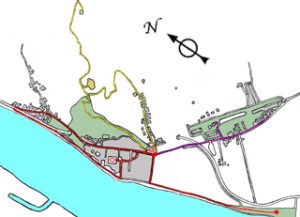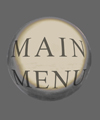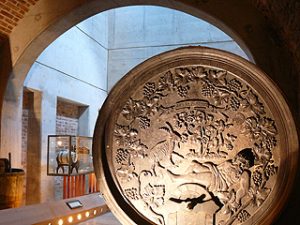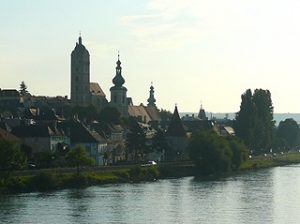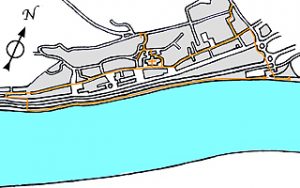Wine is Everything
Welcome to this Reloading Humanism guide that explains how wine is everything and in wine, there is truth. The tour works through the use of buttons which when pressed initiate a Googe Chrome plug-in that reads the English texts. Once started, pressing the button again stops the reading. Pressing a third time restarts the reading from the beginning. Street directions are therefore at the beginning of each tour item so that the repetition of instructions is straightforward.
THE ORIGINS OF WINE-MAKING
Wine-making can be dated back to the Neolithic. This is a period that began some nine thousand years ago. With the Neolithic, the semi-nomadic hunter-gather groups of the Ice Age became settled. Living in small communities people supported themselves through farming. This brought a new world-view into being, fragments of which can be discerned. Right from the beginning, grapes and wine were integral to the mythology of the new religion. Like most plants in Europe, each winter, the vine dies back and appears as if dead. Then in spring, it puts out new shoots and grows again. By the time summer arrives, it has achieved spectacular growth. The vine was thus seen as a manifestation of a god who embodied the changing seasons. Each year he rose again, as if from the dead.
A GOD OF CHANGING SEASONS
Like the changing seasons, the god of the vine had changing facets and could change form. In spring he was personified as a handsome youth. In Summer, he was the bull of harvest. In the autumn he shrunk to became a mask that was entwined with vines. In this aspect he was the Green Man. This motif that can be found in churches throughout Europe. In European folklore, the green man is equivalent to the Wild Man. In the winter, there was no trace of the handsome youth, the virile bull or of the Green Man. Instead, at the winter solstice a Yule Log would be burnt. Then its ashes would be scattered over the fields. This was so as to ensure that the cycle would start again.
THE GOD OF THE SEASONS AS A BULL
The reason why the god was associated with a bull is written in the stars. During the Neolithic, the constellation of Taurus became visible in the night sky at the beginning of spring. Visible throughout the summer, at the beginning of the harvest season, it would then disappear again. Both in nature and as a personification of summer, the bull represented a peak of strength and virility.
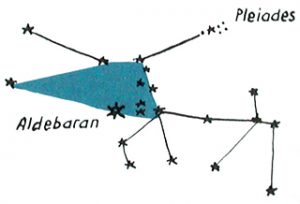
The constellation of Taurus, from The Stars, a new way to see them, H. A. Rey, Boston, 1952
THE GOD OF THE SEASONS AS A GREEN MAN
With the onset of harvest, bulls were sacrificed in thanks and the god of the seasons was prompted to change form yet again. Becoming the Green Man, he represented the autumnal phase of the cycle. This was when the late ripening fruits such as grapes and figs were harvested. Wine was made and in the Middle East, wine was kept in skins made from the hides of bulls.
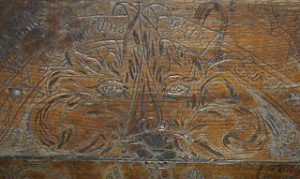
The Green Man as a vine leaf, detail from the engraved table top of a table from a wine-grower’s cellar, J. Lischka, 1920, Museum Krems. The moto above reads: „God is with us now and forever“
DESICCATION
During autumn, the sap of life and the male forces of nature dried up. Then with the onset of winter proper, the world became cold and frozen. Only when the cold of winter had run its course would the sap return. Then and only then, could the Green Man of vegetation and the Wild Man of rampant growth return.
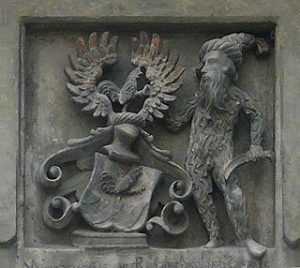
Relief showing the arms of Dr. Wolfgang Kappler and a wild man, anonymous, Marktgasse 1, Krems, 1532
THE GODDESS BEHIND THE SEASONS
For all his impressive vigour, the god of the seasons was but an aspect of something greater. This was the Alma mater, the great goddess, who was lay behind and embodied all things. Like her male consort, the great goddess was multi-faceted and ever-changing. In human form she was maiden, mature woman and old hag. The maiden represented spring, the mature woman summer, the old woman, autumn. During the winter she withdrew and was an embodiment of death and desiccation. Due to this pattern, the goddess was associated with the moon. The first crescent was analogous to spring, the full moon to summer, the second crescent to autumn. Like winter, the period of withdrawal was associated with the never seen, new moon. The moon’s crescents meanwhile, resembled the horns of the bull, the goddess‘ consort in summer. In this way, the male principle of life was seen as integrated into a more all-encompassing female aspect.
THE GODDESS AS BIRTH-GIVER
That all things were seen was emerging from the goddess is shown by images which show the goddess as a toad. This draws on the similarity between the toad’s natural posture and a woman giving birth in a crouched position. From the Neolithic, this tradion continued on into the Bronze and Iron Ages. An example from Lower Austria gives the form of a toad in three-dimensions. Modeled in clay, when turned over, on the underside there is a low relief depiction of a woman who has just to given birth.
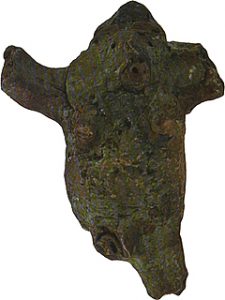
The Lady Toad of Maissau 1,100 BC, Höbarth Collection, Horn
THE GODDESS AND HER MORTAL LOVER
Where the great, all-encompassing goddess could metamorphose from one transition to another, her consort, being subservient, had to die. Reflecting this, in numerous numerous myths tell of a goddess and a mortal lover, who dies in the prime of youth. The great goddess incorporates within herself, the principles of both life and death. Yet her consort knows only life. Accordingly at the end of each life-phase he must be moved on through the holding rituals, rites and sacrifices.
THE GOD OF SPRING
Spring is a time when everything in nature is new and pristine. When this phase passes, spring must make way for the ripening bounty of summer. As today, the arrival of spring was celebrated at Easter. Then at the beginning of May, spring was celebrated again, only this time it was so as to bid him farewell. In Austria, May Day is marked through the erecting of huge poles in the squares of towns and villages. The poles are the trunks of fully grown pine trees. Stripped of their branches and bark, they are topped by a small Christmas tree. Around the pole, may pole dances are performed. Competitions are also held in which young men climb up the pole. In these customs, faint echoes may be seen of rites that celebrate youth and fertility.
THE GODDESS AS MAIDEN
In Austria, the goddess in her youthful aspect is shown by the Sala Women or Saligians. Again referring to newness, the expression means, the glowing, or shinning ones. As presented by later cultures, the Saligans are Wild Women, as they shun the benefits of civilisation. In the woods they protect wild animals and punish hunters who shoot more than necessary. Living by rivers and in woods, they sleep in caves and rocky crevices. When they tire of sleeping on hard surfaces, they enter a human dwelling and sleep on a free bed. As a payment, they leave a lock of hair which can be spun into thread for ever. From high places they sometimes descend and help farmers. Echoing the three-fold nature the goddess from which they derive, the Saligians are thought of as appearing in three’s.
THE GODDESS AS MOTHER
Presenting the goddess as a form of harvest deity is the figure of the Corn Mother. This is an old woman with fiery fingers and breasts that have iron spikes on them. For the farmer, it was essential to leave a last ear of corn standing for her in the field. Another form of the goddess in her last incarnation is Frau Holle, who is an old woman with bad teeth. Known as Hulda or „she who should be honoured“, in Austria, she is also known as Frau Percht. Apart from the corn, Frau Percht is associated with fertility, rebirth and metamorphosis in general. When she shakes her bed, feathers escape. These form clouds that dictate the weather. As the clouds were thought of as being spun, Frau Percht is the goddess of spinning and weaving. She supports those who are industrious and punishes those who are lazy. Frau Percht has a variety of appearances. She can appear as an enormous woman with flaxen hair and a white dress. Alternatively she appears as a withered old woman with an iron nose.
THE LAST VESTIGES OF SPRING AND SUMMER
After the summer harvest, all that remained of the goddess‘ consort were the later ripening fruits of autumn. These included the grapes of the once so vigorous vine. Yet when the grapes are pressed, they immediately start to ferment. Despite being battered and squashed, something in the brew is alive. Then when the juice is drunk, an alien power rises to one’s head. This was seen as a manifestation of the god. Although dead, his spirit was thought of as living on in the wine that had been made from the fruit of his body.
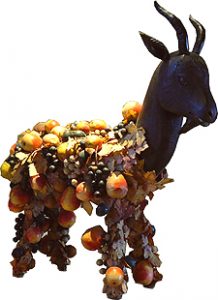
Vineyard spirit carrying the fruits of autumn, Lower Austrian, date unknown, Museum Krems
THE GOD OF THE SEASONS REBORN
For the Ancient Greeks there was no doubt that the intoxicating power of wine was a direct manifestation of the god of the vine. This was Dionysus, whose name means, a burst of light. Dionysus‘ mother’s was Semele, whose name means, earth. The two together thus refer to the fact that the Earth only becomes fruitful when warmed by the light of the sun. Thus both through his attributes and via name, Dionysus is a form of Green Man who once embodied the cycle of the seasons. Meanwhile Dionysus‘ father was the sky-god Zeus, who when on Earth, frequently appeared as a bull.
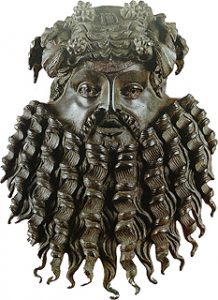
A mask depicting Dionysus. The mask was originally part of a handle for a large vessel, probably a situla in which wine was mixed. Roman, 1st century AD. Collection of Greek and Roman Antiquities, Kunsthistorisches Museum Vienna
THE GOD OF THE SEASONS IN DELPHI
For nine months of the year, the temple at Delphi was sacred to Apollo. Apollo was the god of prophecy and like Dionysus, was associated with light. As the two were half-brothers, from December to February, the temple at Delphi was sacred to Dionysus. Every second year, Athenian women were allowed to leave the confinement of their homes and go to Delphi. This took place in February, with the explicit purpose of honouring Dionysus.
BACCHIC RITES ON MOUNT PARNASSUS
When it came to intoxicants and hallucinogens, and being possessed by their god, the women going to Delphi saw no need to stop at wine. Winter is the mushroom season in Greece. Wandering over the slopes of Mount Parnassus, they found Amanita Muscaria. Eating the red and white mushroom the women had powerful altered states experiences. Calling themselves maenads, they would run wildly over the slopes with their heads thrown back. Apart from hallucinations and senseless abandonment, they experienced upsurges in erotic energy and acquired remarkable strength.
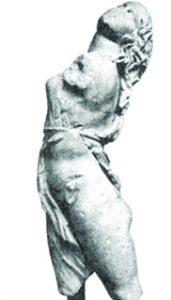
Maenad, 4th C. BC, Collection of Sculptures, Staatliche Kunstsammlungen Dresden
MAENADS IN THE SNOW
Both written accounts and depictions on pottery show that the women would not balk at handling snakes and fire. They would also tear wild animals to pieces and eat the raw flesh. For a few hours they would rampage over the slopes of Mount Parnassus, possessed by their god. After the wild abandon, they would be found lying exhausted among the snow. Needless to say, the women observed a code of secrecy concerning what they did. Yet to prevent them from dying from hypothermia, they had to be rescued. An eye-witness account says that they would be found lying on the ground, their clothes frozen as stiff as boards. Thus by the time Euripides wrote the Bacchae, everyone knew, or thought they knew, what was being referred to.
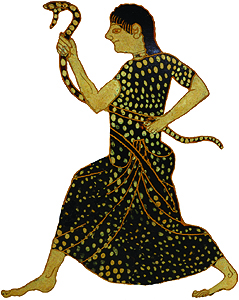
Maenad with a snake, detail from a black-figured hydria, the „Eagle Painter“, East Greek, ca 520 BC, Collection of Greek and Roman Antiquities, Kunsthistorisches Museum Vienna
THE BACCHIC RITES IN ITALY
From Greece, the Bacchic cult spread to Italy. The rites were held in secret and often led to excesses. Leaking out, this prompted a series of politically motivated scandals. Political intrigues then led to adherents of the cult being accused of conspiring against the state. After a scandal in Campagnia, the cult and its rites were banned in 186 BC. To this effect the Senate issued a decree. This was publicised through the displaying of bronze plaques in prominent public places. In 1640, one such plaque was found in Calabria. In 1727, it was framed and presented to Emperor Charles VI of Austria.
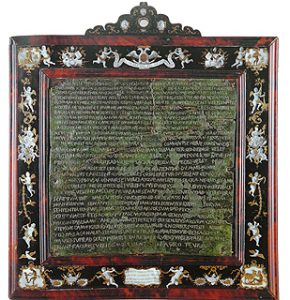
Plaque announcing Senatus Consultum de Bacchanalibus, Roman Republic, 186 BC, Collection of Greek and Roman Antiquities, Kunsthistorisches Museum Vienna
THE COVENANT BETWEEN GOD AND ABRAM
In the Book of Genesis, The Holy Bible, describes how Abram helps a number of kings defeat an alliance of other kings. As he returns, he is met by the Kings of Salem and Sodom. Melchizedek, the King of Salem, is also a High Priest. Bringing bread and wine to Abram, he blesses him. To this effect he says:
Blessed be Abram by God Most High,
Creator of Heaven and Earth.
And praise be to God Most High,
who delivered your enemies into your hand.
Although the King of Sodom offers goods in return for his military services, Abram declines. This is because he has sworn to God, not to take rewards. For rewards would reflect on the king and not upon God. Thereafter Abram has a vision. The Word of God says:
Do not be afraid Abram,
I am your shield,
your very great reward.
God then promises Abram that his descendants will be as numerous as the stars in the sky. This is the first mention in The Bible of wine in a sacred context. Melchizedek’s blessing paves the way for the covenant made by God with Abram.
JESUS AND THE LAST SUPPER
An important part of Christian thinking is the drawing of analogies between the Old Testament and the New Testament. This is because the Old Testament is seen as anticipating and preparing the way for events described in the New Testament. In The Holy Bible, the vine is a symbol for the House of Israel. This was the tribe to which Jesus belonged. In the New Testament, Christ says that he is the true vine and that God the Father, is the wine-grower. At the Last Supper, Christ exhorted his disciples to break bread and drink wine in remembrance of him. This is because he says, the bread is his body, the wine is his blood. Like Melchizedek, Jesus was using the bread and the wine as something that pointed to a covenat. This was the doctrine of the remission of sins drawn up by God and sealed by Christ through his suffering and death.
CHRISTIANITY AND THE GOD OF THE SEASONS
In both the Neolithic tradition and the Christian tradition, the vine is a personification of a figure who was destined die. Conquering death, both Jesus and the god of the seasons, rise again. It was therefore easy for Christian missionaries to argue that Christ was a new form of this older concept. Missionaries and priests were thus allowed to hold Christian services at pagan temples. This they did with the idea of subverting the old religion, subtly steering it towards Christianity. The problem was that the old ways were not so easily eradicated. For hundreds of years, the two traditions existed side by side and in varying forms of fusion. Over time, this appears to suited not only local populations but also local priests.
Reflecting the fusion of the old religion with the new, depictions of vines occur in churches throughout Europe. Green Men and other clearly non-Christian motifs also abound. This is not only true of early Romanesque churches but also of much later Medieval churches. Examples may even be found that date from the sixteenth century. A Romanesque example is on display in the cellars of Museum Krems. This shows the goddess of the Neolithic as a harpy in her death aspect.
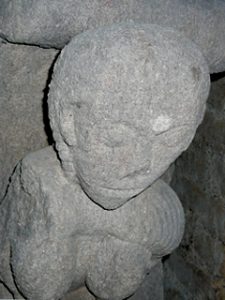
Harpy, Early Christian Age, Museum Krems
THE GODDESS RELIGION AND THE CHURCH
Although local priests were not opposed to the fusing of Neolithic and Christian traditions, Church Bishops did not approve. In letters, Bishops repeatedly urged local priests to ban pagan activities from being held on church ground. In some countries these bans were effective. In others they were ineffective. During the Renaissance, there are reports of people dancing in churches during sermons. The inability of the Catholic Church to stamp out dancing in churches was one of the complaints brought by Luther. With the Counter-Reformation however, appropriate measures were taken. The result was that in both Protestant and Catholic countries, dancing and the holding of fairs on church ground was eradicated.
THE SUBVERTED RITES OF FRAU PERCHT
With the Reformation and Counter Reformation, throughout Europe, pagan traditions that were not banned were secularised. An Austrian example of a custom that survived through being subverted, is Perchten Running. This is held at the beginning of December. The purpose of this practice appears to have been to emphasise the withdrawal and seclusion that the approaching winter solstice demanded. The rites involve young men dressing up as demons. Clad in furs and wearing grotesque masks with large horns, they yield whips and shake chains. With the Counter Reformation, this practice was turned back on itself. Instead of honouring Frau Percht and her withdrawal to the sacred space of a church, she was expelled from it. The goddess expelled, the rite then became one in which women and girls who dared to go out, were chased through the streets. In modified form, Perchten Running may still be seen today.
THE HOLY COMMUNION OF CHRISTIANITY
At the Christian ceremony known as Holy Communion, the communion referred to is a communion with God. Via the bread and wine which were used as sacraments, this recalls the covenant made between God and Abram. Following what Christ said at the Last Supper, the bread stands for the body of Christ, the wine for his blood. After a ceremony, believers eat a small piece of the consecrated bread and drink a sip of the consecrated wine. For Protestants, the bread and the wine are merely symbols. For Catholics however, a miracle has taken place. The bread and wine are not symbols but have been literally transformed into the body and blood of Christ. Yet seeing an analogy between Christ’s genealogy and Passion, and the vine and its fruit, offers another way of viewing the matter. As the new Green Man, Christ is the vine and is associated with wine-making. If one accepts the analogy, the link being literal and there is no need for any form of transformation. Yet thinking and seeing things in terms of analogies is alien to the modern mind-set. This means that the matter becomes polarised into a question of, miracle or symbol? Nevertheless, during the Middle Ages, among the illiterate, seeing the world in terms of analogies is likely have to have been predominant. This is suggested by the attention given in art to the stations of the cross.
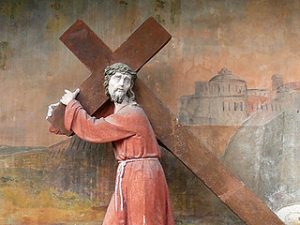
Christ carry the Cross, Stations of the Cross, Piarist Church, anonymous, 1658, Krems
THE PASSION OF CHRIST AND WINE-MAKING
Once picked, the grapes were placed in tall, narrow containers where they were bashed with thick poles. Then they were shovelled into a barrel. This was mounted on a cart so that the must could be carried down for a second, more thorough pressing. The reason for the initial battering was to save space. The battering and the journey in the cart were analogous to the torture and mockery that Christ went thorough prior to being crucified.
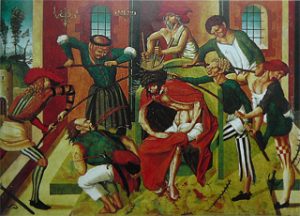
The Flagellation of Christ from the Aggsbach Altarpiece, Jörg Breu the Elder, 1501. The altarpiece was painted for the Charthouse at Aggsbach. This was dissolved in 1782 and the altarpiece is now in the Augustine Monastery at Herzogenburg
THE CRUCIFIXION, THE BURIAL AND WINE-MAKING
Thereafter, where the pressing of the grapes was the crucifixion, the storing of wine in a cellar, was his Christ’s burial. During the Middle Ages, these parallels lead to the notion of Christ as „the Man of Sorrows“. This made human beings were nothing but mean, wretched sinners. The despicableness of human nature was such that it was not enough for God to sacrifice his only son. The son had to undergo a programme of mockery, torture and humiliation as well. Simply by virtue of being human, human beings were inherently wretched and sinful. Exemplifying this conception, a half-size crucifix in Museum Krems shows Christ hanging from the cross. Emaciated and exhausted, from the Saviour’s wounds, blood flows in hyper-real, three dimensional forms.
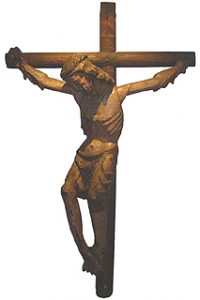
Crucifix, mid 14th century, Museum Krems
A BACCHIC FORMULAR
Shying away from the analogies that can be drawn between the effects of wine and Christ’s rising from the dead, the Church did use the letters, I, H, S. This was a formula used by the followers of Bacchus in Italy. These stood for, in hic salus or in hic signo, both of which mean, in this sign. Unfortunately it is not known what sign or object the expression refers to. It be the staff borne by Bacchus and his followers. This consists of a long stalk of fennel, topped by a large pine cone. The significance of this is that stalks of fennel were used by Greek apothecaries for storing drugs. Later the letters I, H, S, were interpreted as standing for, Iesus hominum salvator. This means, Jesus the Saviour of Man. Cut free from their previous sphere of meaning, the letters may be found in churches and paintings the world over.
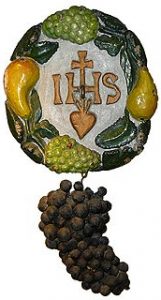
Insignia of the Wine-Growers‘ Guild, 1739, Museum Krems
THE LIGHT OF THE WORLD
Following an age-old system of identifications, the Church equated all that was good, true and beautiful with light. Darkness was demonised and stood for all that was bad and corrupted. This was meant that Christ, as the conqueror of darkness, was analogous to and so was, the sun. He thus became the Light of the World. Meanwhile his mother, the Virgin Mary, became Queen of Heaven. Born on the day of the winter solstice, Christ was the conqueror of darkness and evil.
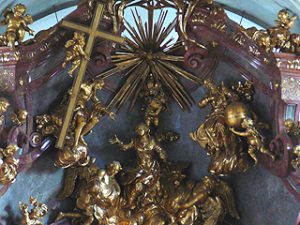
Jesus receiving Mary as Queen of Heaven, Joseph Matthias Goetz, Parish Church of Saint Vitus, 1732-1736, Krems
A NEW VISION OF HUMANITY 1
With the Renaissance, the ways in which past events were seen as prefiguring New Testament events were extended. Via the equation that linked Christ with light, Jesus was seen as being prefigured by the half-brothers, Apollo and Dionysus. Meanwhile, God the Father was seen as being anticipated by the fatherly figure of Zeus. In this way, scholars and theologians lessened the emphasis on sin that had characterised the Middle Ages. No loner inherently wicked, a new view of humanity was ushered in. Reaching up towards the light, people were accorded the ability to do good and to perform noble deeds. This can be seen when two Renaissance sculptures in Museum Krems are compared with the crucifixion image already encountered. These show Christ very much alive, standing on his own two feet and showing his wounds. Though the wounds are clearly depicted, the poses show no signs of pain or suffering. In the first example, the message is: It was for you that I allowed them to do this to me. Look, believe and I shall absolve you from sin.
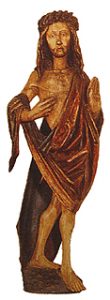
Christ Arisen, anonymous, around 1470, Museum Krems
A NEW VISION OF HUMANITY 2
Where the first figure of Christ Arisen is addressing us, the second is caught in an act remembering the torment and seems to be saying, Yes, it was out of love for you that I did this.
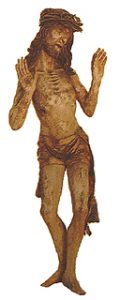
Christ Arisen, anonymous, around 1480, Museum Krems
FORGIVENESS IN DÜRNSTEIN ABBEY
In the Festive Hall of Dürnstein Abbey, a fresco on the ceiling shows a scene from the New Testament. This is an incident told in Luke, in which Jesus was invited to share a meal with a Pharisee. Seeing Jesus enter the building, a woman followed him. When he had taken his seat, she presented him with an alabaster jar filled with ointment. Then she broke down in tears. Using the water of her tears, she washed Jesus‘ feet. Afterwards she dried them with her hair and kissed them.
The host saw that the woman was a prostitute. If Jesus was a prophet he wondered, why would he let a prostitute touch him? Overhearing the aside, Jesus asked him a question. There are two debtors, One owes a lot of money, the other only a small sum. If the creditor cancels both debts, which of the two would be more grateful? To this the Pharisee replied that the one with the greater debt would be more grateful. You are right, Jesus said. He then pointed out that when he arrived, no one had given him water to bathe his feet. No one had kissed him. No one had anointed him with oil. The woman’s sins were many, Jesus admitted. Nevertheless she was repentant and he accordingly declared her sins forgiven.
At this, the Pharisees began to mumble discontentedly among themselves. Who is this who dares to declare such sins forgiven? The Festive Hall was where the Provost of Dürnstein Abbey, Hieronymus Übelbacher, would receive important guests. The fresco sets the tone for how Übelbacher saw his role as host. Overriding all else, the best reason for any celebration, was God’s love of the world. Out of this, he sent his only son to die. By conquering death and rising again, Christ was able to absolve humankind kind from sin. In any coming together, the most important thing was penitence and to forgive as God forgives us.
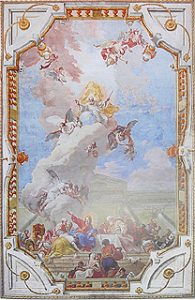
Jesus, the Harlot and the Pharisee, Martin Johann Schmidt, 1775, Festive Hall, Dürnstein Abbey
WINE IS EVERYTHING
Alluding to the theme of forgiveness announced on the ceiling of the Festive Hall in Dürnsten Abbey, is a building just outside the town. If at Dürnstein, one looks from the Steiner Tor to the north-east, a yellow and white building stands out. This was built by Übelbacher as a Lustschlossl, or palace for the appetites. Inside a motto proclaims, Wine is everything. Even more confidently, another proclaims:
Wine is over and above everything.
These mottoes refer to two things. On the one hand, they refer to the role of wine in the Christian Sacraments. On the other, they refer to Übelbacher’s joie de vivre. Well-earned and in their right place, the joys of man do contribute to the joy of God. Seeing life as nothing but a test that decides whether one goes to Heaven or to Hell, belies the beauty and complexity of God’s creation. It is thus our duty to graciously accept the joys of life and give thanks for them, by appreciating them. The relevance of this is that it was in the Lustschlossl that Übelbacher entertained his friends. Reading between the lines of his diaries, it is clear that on occasion, Übelbacher and his friends lived it up. The fresco in the Festive Room of the Abbey and the two mottoes, both point to something. This is doctrine of the forgiveness of sins with which all iniquity is washed away. Christ is the wine that washes away sin, yet wine is also that helps us celebrate the joys of life, as God the Father intended.
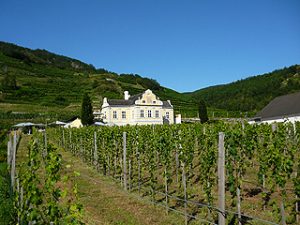
The Lustschlossl built by Hieronymus Übelbacher at Dürnstein
GUARDIAN STARS
From the end of August until the middle of November, wine gardens were closed to public access. This was to prevent unlawful picking. During the period of ripening, guards lived among the vineyards in huts which still dot the landscape today. To show that the vineyards were closed, long poles topped by stars were erected and adorned with bunches of thistles. The first mention of such a pole being erected in the Wachau, dates from 1394. Made of strips of wood, these „Hütersterne“ are composed of dozens of Saint Andrew’s crosses arranged either in a radial fashion or in concentric rings. The stars, recall the wandering star that in The Bible, the three wise men followed. Arriving at Bethlehem, it stood still over as an announcement of Christ’s birth.
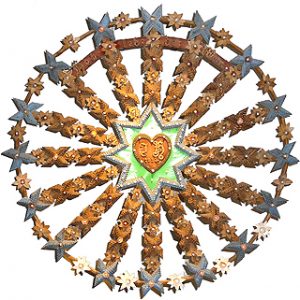
Hüterstern or guardian’s star, 1913, Museum Krems
WINE-GROWERS AND THEIR SAINTS
The wine-growers had a number of patron saints. These included the Virgin Mary and Saint Paul. Two saints were however unique to wine-growers. These were Saint Urban and Saint Martin. Saint Urban died a martyr’s death in 230. As Bishop of Langres he is credited with bringing the cultivation of the vine to his diocese. At some stage he evaded persecution by hiding under the leaves of a vine. This was possible as up until the nineteenth century, vines were planted to grow up and around poles. The poles stood alone and the climbing vines formed bushy outcrops. Under the vigorous growth, there was space enough for fugitives to hide. As Saint Urban was compelled to hide, not for days but for weeks, he fed himself on grapes. The vine thus gave him both camouflage and sustenance.
Where Saint Urban was responsible for wine-making in general, Saint Martin was specifically concerned with the fermenting and ageing of the wine. Evidently an imposing personage, he was invited to dine with the Roman emperor, Maximus. On this occasion, he was accorded the honour of being allowed to take the first sip of wine. Out of this, there arose the belief that after pressing, it was Saint Martin was who oversaw the wine’s subsequent transitions.
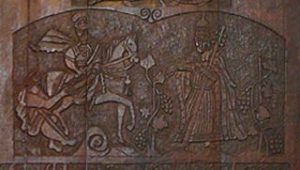
Saint Martin (right) and Saint Urban (left), detail from a relief carved on the end of a barrel, 1857, Museum Krems
THE DAY OF SAINT MARTIN
In Austria, the still fermenting wine is known as sturm. Murky, cloudy and sweet, it can be sampled in vineyard taverns in October. After ten days, the yeast settles and the still dusty wine is tasted. Pumped out into fresh barrels, the wine is known as young wine. From this moment on, the barrels must be kept full so as to prevent oxygen from spoiling the wine. The 11th November is Saint Martin’s Day. On this day the new wine was traditionally christened and officially presented. On Saint Martin’s day, goose is eaten.
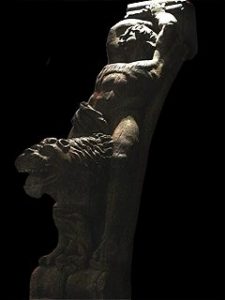
Figure of a youth riding on the back of a lion representing the young wine, wine-press support, Ladendorf, 17th C., Museum Krems
NOAH AND WINE-MAKING
In a secular context, wine appears early on in The Bible. First mentioned soon after the Flood, The Bible says that Noah became a man of the soil and planted a vineyard. Following in Noah’s footsteps, wine-growers clearly played a part in the Christian story. Yet as lay people, they knew it was not their place to claim too much of a central role. Accordingly they associated themselves with Noah. This enabled them to be close to the central mystery without making any undue claims. In Lower Austrian folk art, Noah is often shown together with a goat. This is because The Bible gives no explanation of how the Patriarch came to invent wine. Regional tradition filling in, the saying is that it was a nibbling goat that prompted him to try the unknown fruit. After harvesting a sample of grapes in a pot, Noah was then distracted. By the time he returned, the grapes were fermenting. Yet undaunted, he drank the brew. As The Bible then says, overindulging as, the Patriarch became inebriated and fell asleep. Later, he was found lying naked on the ground and was discretely covered by his sons.
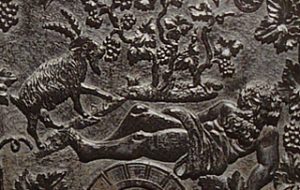
Noah and the goat, detail from a relief carved on the end of a barrel, 1881, Museum Krems
THE SCOUTS OF ISRAEL RETURN
In the Old Testament another reference to grapes occurs in Numbers, 13:23. Arriving in the Promised Land, God instructs Moses to send out scouts. As a proof of the land’s bounty, the scouts return with a bunch of grapes. The bunch is so huge that it is hung over a pole and carried on the shoulders of two men. As shown carved on the end of a barrel in Museum Krems, a text accompanies the scene. This hints at the problems encountered by Noah when he first sampled wine. Translated, it reads:
The scouts have brought
the wine home
and for sure the monkey
won’t be far away.
This is a reference to a Jewish interpolation to the story of Noah.
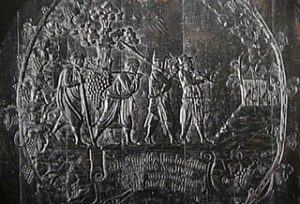
The scouts of Israel returning with grapes, detail from a relief carved on the end of a 1,890 Litre barrel, Museum Krems
NOAH IN THE MIDRASCH TANHUMA
In the Midrasch Tanhuma, the Devil sees Noah planting up his vineyard. Going over to him, he asks what he is doing. Noah replies that he is planting out vines on which a sweet fruit will grow. Hearing this, the Devil suggests that they enter into a partnership. For his part, the Devil promises to make a sacrifice that will double the yield. Once harvested they can then divide the grapes equally between them. To this, Noah agrees and the Devil duly sacrifices a sheep, a lion, a pig and a monkey. These he buries in the soil that Noah has planted up. The Devil then says that the juice of the fruit will make whoever drinks of it mild like a sheep. If more is drunk, the person will acquire the courage of a lion. Yet continued, over-indulgence will make them behave objectionably like a pig. Thereafter, whoever continues over-indulging, will behave like a monkey. To the believer who drinks wine, Christ offers joy and forgiveness. For non-believers, the Devil holds up a mirror that peers ever more deeply into the murky depths of the human soul. For both believers and non-believers alike, there is truth in wine and in many senses, wine really is everything.
END OF „WINE IS EVERYTHING“
Krems Tour: Trade and Prosperity, Heresy and Belief
Welcome to this Reloading Humanism tour of Krems. The tour works through the use of buttons which when pressed initiate a Google Chrome plug-in. This reads the English texts. Once started pressing the button again stops the reading. Pressing a third time restarts the reading from the beginning. Street directions are at the beginning of each tour item so as to facilitate the repetition of instructions.
To begin the tour go to Körnermarkt 14. Entering Museum Krems say that you wish to see the model of the town, which is located in Room 2 and for which there is no entry fee.
MUSEUM KREMS: MODEL OF THE TOWN
The model shows the town as it would have looked between 1760-1795. The main features of the town such as city-walls, streets and churches were established by the fourteenth century. The first settlement was built on a rocky outcrop that overlooked a wet-land landscape. This was caused by the meandering Danube. On the model, the site of this first settlement can be seen above the town’s eastern gate. Here there was a pallas or stockade where refuge could be sought in times of danger. To the North-West, the trapezoid square with three trees and a covered well in the middle, was where markets were held. This is the Hohe Markt or Upper Market. In due course the stockade was rendered superfluous by the building of a castle. This was situated on the South side of the Upper Market. In the thirteenth century, the castle was transformed into a town palace, identifiable on the model by its castellation’s.
The settlement was first mentioned in 995 in a document drawn up after the Battle of Lechfeld. This battle was fought near Augsburg in Germany. At the battle, a marauding army of Magyars from Hungry were defeated. Following this decisive victory, the soon to be Holy Roman Emperor, Otto III, initiated a program of colonisation. Following this program the unsettled and uncultivated lands of the Wachau were given to monasteries in Southern Germany. The monks quickly realised that the slopes of the valley were ideal for growing wine. Large areas of the Wachau and the area around Krems were transformed into a patchworks of vineyards owned by different monastic institutions. In this way, craftsmen and traders were attracted and slowly, law abiding communities were established.
MUSEUM KREMS: SAINT VITUS
By 1014, Krems had grown to such an extent that land was granted to the parish church. This was so that a larger building might be built. Situated immediately below the original church, it was not until a century later that the new church was completed. Built as a Roman basilica, the new church was dedicated to Saint Vitus and was linked with the old church by stairways. Saint Vitus was the patron saint of apothecaries and dancers and was invoked in cases of epilepsy. In Room 2, a sculpture dating to around 1520 shows him in a vat with his hands clasped together in prayer. Vitus was martyred as a young man by being placed in a vat of boiling oil. Praying that he might withstand the torment to come, he was lifted up to heaven by a swarm of angels.
MUSEUM KREMS: COINS
Between 1120 and 1194, coins were minted in one of the castle towers. In Room 2, examples of these Kremser Pfennige or Krems Pennies are on display. The reverse of the coins often features a walled city with gates. The existence of a city-wall with gateways in Krems is attested to in documents that date from 1188 and 1193. The town depicted on the coins can thus be assumed to be Krems itself. Meanwhile the obverse often shows a figure holding two lions by their tails. Alternatrively the figure is in combat with a lion. Krems or Garmisia was the only European settlement outside Italy that the Arab geographer, Idrisi gave a name to on his map of the world of 1153. This was a result of the Krems Pennies being used as currency abroad. In 1196, Krems was important enough to be made a judicial seat. In Room 2 there is a cupboard where the town’s judicial documents were kept. Also on display are a judge’s sword and sceptre which were symbols of office.
THE FOUNDATION OF THE DOMINICAN MONASTERY
Leave Museum Krems and walk South past the golden rain tree. Cross the square at its narrowest point. Then turn around to look back at the Dominican Church. During the Middle Ages schools and teaching slowly became established. This resulted in boys being taught by monks at grammar schools. With education people began to think for themselves and questioned Church doctrine. This resulted in heresy. The most well-known heretics of the Middle Ages are the Cathars. For the Cathars, there were two gods one good and one evil. The evil god was the creator of matter and was the god of the Old Testament. The good god was the creator of spirit and was the god of the New Testament. Cathars believed that human beings were sexless spirits caught in the material realm of the evil god. Cathars sought to escape perpetual reincarnation in the material world, by returning to the good god of the New Testament. To counter the danger of schism that these and other beliefs brought, the Order of Dominican Friars was founded in 1216. In 1238, Dominican monks from Hungry were summoned to fight the heresy which had broken out in Krems. In 1240 work started on the building of a monastery. As there was not enough space inside the town, the monastery was situated outside the city walls. Unlike the other religious orders, the Dominicans wanted to be close to the people whose souls they wanted to save. After twenty years the church was completed in 1260. It is assumed that the rest of the monastery was also finished at this time. In 1315 an inquisition identified sixteen people in Krems who denied essential aspects of the Catholic faith. In the report the heretics were recorded as doubting the authority of the Church and its priests. Burnt at the stake, the heretics were not without sympathisers for a Dominican Friar, was sized by a mob and killed with a sword. Buried in a stone coffin in the Dominican Chruch Father Arnold’s body was exhumed in 1639. Examination of his bones revealed sword wounds to the head and upper arm. Whether those burnt were Cathars or Waldensers is unknown. Less radical, Waldensers questioned whether Church officials were qualified to preach the Word of God. They also rejected the cult of relics and Holy Water. For a Waldenser it was irrelevant whether a person prayed in a barn or in a church. Refusing to recognise the authority of the Pope, Waldensers are seen as precursors of the Reformation. Sometime before 1330, the small apse of the Dominican Church was knocked down and replaced with a larger structure. Still standing today, this is decorated in a High Gothic style.
OBERE LANDSTRASSE 1
From opposite the Church, follow the Gaheisgasse down to the Obere Landstrasse. In Krems, the beginning of the thirteenth century brought a second phase of expansion. From the South of the rocky outcrop, the town spread out towards the West. During this phase the old high street, the Untere Landstrasse, was extended westwards to form the Obere Landstrasse where you now are.
At the Obere Landstrasse, turn left and then immediately right. Proceeding along the Sparkassengasse leads to Hafnerplatz. At the southern end of the square, there are two Medieval buildings. The left-hand building was a chapel and was built in around 1250 as part of a defensive complex. This complex was designed to guard the town’s south-western corner. The outer walls and a defensive structure known as a pallas are around the corner from the chapel. During the fourteenth century, the area to the north-west of Hafner Platz was partially occupied. As the fourteenth century drew to a close, the town’s walls were moved outwards to include this north-western area.
CITY WALLS
To see the last remains of the town’s outermost city-walls walls, leave the Hafner Platz by going West. Follow the Fischergasse as far as Schwedengasse and then turn right into the Schwedengasse. Immediately on your left there is a small fragment of city wall. Continuing on along this lane, brings you to a much larger, restored fragment. From here the Steiner Tor can be seen immediately ahead.
STEINER TOR
The Steiner Tor is named after the town of Stein, in whose direction the Tor, or gateway points. Going through the gateway and gaining a distance from it affords a better view. The two round towers date from the end of the fourteenth century. The central square structure was built a century later by Emperor Friedrich III. In 1477, Krems was besieged by the forces of the Hungarian King, Matthias Corvinus. Although the town was able to hold out, the encounter showed that old walls only offered partial protection against modern weaponary. Accordingly, the town’s walls were strengthend and its towers were made to protrude out further. This was so that defenders would be better placed to shoot at intruders attempting to scale the walls. In 1485, Matthias Corvinus sent a second force and the recently modernised defences successfully withstood the siege. On the outside of the gateway, next to the date 1480, there are the letters A, E, I, O, U. This is an abbreviation for „Earth Is Under Austrian Omnipotence“. Friedrich’s rule was challenged, not only by Matthias Corvinus but also by his own brother Archduke Albrecht VI, who was also unsuccessful. Friedrich’s ambitious motto can be seen as prophetic, for a few hundred years later Austria was an empire.
OBERE LANDSTRASSE 2
Return back through the gateway and follow the Obere Landstrase East as far as Farbergasse. At Farbergasse turn left and then at the end of the street, right into the Schlüsselamtgasse. Here you will pass the Schlüsselamt or Key Office. This was where the old city-walls were before they were extended. At the Key Office there was a gateway where the keys to the town could be borrowed. In times of danger the monks would abandon the monastery and seek refuge within the town. Following the Schlüsselamtgasse eastwards brings you to Krems Parish Church. Due to its size this church is also known as The Cathedral of the Wachau.
THE OLD HOSPICE
At the end of the Schlüsselamtgasse, look up to the left for a view of the Piarist Church. Below, on the northern side of the square, a ramp leads up towards the church. Leaving the Cathedral of the Wachau for later, cross the square and go up the ramp. At the top of the ramp, there is the entrance to the original Bürgherspittal, or Old Burgesses’ Hospice. During the Middle Ages this was here that the sick, aged and infirm were cared and provided for. In conjunction with the parish church the hospice was managed by the wealthy and privileged citizens who ran the town.
PIARIST CHURCH TOWER
After the Old Burgesses’ Hospice, a flight of covered of steps leads up the Piarist Church. This covered way is a Baroque construction and either side there are the original paths. Reflecting this, the central path on the right features a Gothic archway. For a view over the town follow one of these four ways up towards the Church.
An essential feature of any Medieval community was an outlook tower. This was manned by a look-out who would raise the alarm whenever a band of brigands or the troops of marauding armies were sighted. It was from such a tower that the Wachau owes its name. The word is an abbreviation of die Wache in der Au or, the watch tower in the marshes. In Krems the outlook tower was the Piarist Church tower. Look out for the Romanesque windows which hint at the structure’s ancient origins. When times became more settled, such towers were still manned so that the alarm could be raised when fire broke out
THE PIARIST CHURCH AND THE REFORMATION
The rest of the Piarist Church is for the most part Late Gothic. This was a Renaissance style that derives from the Gothic of the Medieval Ages. During the Renaissance, Krems and the Wachau were largely Protestant. In Krems, the Piarist Church was popular with the burgesses of the town and those of Protestant persuasion. In the square down below, this resulted in the parish church becoming so neglected that it fell into a state of disrepair.
In 1568, Emperor Maximillian II had allowed a degree of religious freedom for Protestants in the Habsburg Empire. This was through his partial acceptance of what is known as The Augsburg Confession. Full acceptance was dependent on the drawing up and printing of an agenda. This was an order of church service that had to be followed. Prior to being printed the agenda required imperial approval. Initiated by Protestant nobles in the Wachau, the first draught of The Agenda was written in Spitz in 1569. For this difficult task, the Protestant theologian David Chyträus was summoned from Rostock. Chryträus’ text was however only accepted after it had been worked over by Christoph Reuter. Some years before, Reuter had bought a property near Stein. To avoid upsetting the Catholic fraternity at Court, Maximillian was never announced his approval. Instead permission to print was granted on the condition that the operation be carried out in secret. Hidden in the woods above Stein, Reuter’s recently acquired property appeared to be perfectly suited. Thus during the summer of 1470 a temporary printing workshop was set up at Scheibenhof. The first copies of The Agenda were printed in the autumn of the same year. Not as remote as assumed, whilst the Emperor was away, word leaked out that something subversive was going on. This resulted in the printer and his assistants being arrested. When the Emperor returned the matter was clarified and the prisoners released. Nevertheless printing was transferred to the more remote location of Rosenburg and only resumed the next year.
THE PIARIST CHURCH AND THE JESUITS
Following Maximillian’s death in 1576, the imperial throne was inherited by Rudolf II. Like Maximillian, Rudolf had Protestant sympathies. These sympathies were however not shared by his brothers and others at Court. Following the rise of Protestantism, the Catholic fraternity worked hard at promoting the Counter-Reformation in Bohemia, Hungry and Lower Austria. This eliminated Protestantism from the region and the Piarist Church was given to the Jesuit Order. This order was found explicitly to restore und rejuvenate Catholicism. In 1658, a series of sculptures with frescoed backgrounds was made. This leads around the outside of the Pirist Church and show the Passion and suffering of Christ. The story begins at eastern end of the church with The Agony in the Garden of Gethsemene. There then follows, The Flagellation, The Crown of Thorns and The Presentation of Jesus as King of the Jews. These scenes are followed by The Carrying of the Cross, The Crucifixion and Christ in the Tomb. Meanwhile, below the Pirist Church, the delapidated parish church was rebuilt in an opulently Baroque style.
After the Story of the Passion follow the Piaristengasse East. A major focus of the Jesuit Order was teaching and a school was founded. This is the Piaristen Gymnasium or Piarist Grammar School which is what lies behind the high walls.
HOHE MARKT
The Piaristengasse leads out into the top end of the Hohe Markt. Follow the slope down towards the lower end of the square to see the castle. During the twelfth century this was where the Kremser Pennies were minted. During the thirteenth century the entire complex transformed into a Medieval palace. This is the Gozzoburg, named after the tax-collector and financial administrator, Gozzo. To the left there is Gasthaus Jell where regional cooking may be enjoyed. Behind the Gasthaus there is a house which was once a chapel. This is the Katherina Chapel. First mentioned in 1503, the frescos inside the house can be seen by scanning the QR code on the information sign.
WEGSCHEIDT
After the Katherina Chapel, go East. Then turn South to follow the Wegscheidt down a steep slope. At the bottom of the slope, at Wegscheidt 1, lookout for a derrick. This once a common feature serves as a reminder that the prosperity of Krems was built on trade. In the attic spaces of houses, commodities were used stored prior to sale. Where the neighbouring town of Stein had the right to trade in salt, Krems concentrated on ironware. Unlike Krems, the twin town of Stein lay directly next to the River Danube and so could offering mooring facilities for barges. Yet Krems had the advantage of lying on the North-South land route that lead from Prague to Venice. As these advantages were balenced, the prosperity of the two towns was very much linked.
MANHOLE COVER
From the Wegscheidt veer left down to the Unter Landstrasse, or Lower Land Street. Follow this road as far as the ironmongers’ Neunteufel. Here, in the middle of the road there is a manhole with a double-headed eagle. This testifies to an important event in the interwoven histories of Krems and Stein. Although run seperately, many decisions were made jointly. This included an important decision made in November 1462. In 1457, a dispute had broken out between Emperor Friedrich III and his brother, Archduke Albrecht VI. This was prompted by the death of the king of Bohemian and Hungary, Ladislaus Posthumous. The young king’s sudden death lead to the brothers arguing about who should take over the vacant thrones. Renouncing their loyalty to the Emperor, the Viennese favoured Albert. At first Krems and Stein also sided with Albrecht but then the councillors changed their minds. When Friedrich was besieged in his castle in Vienna, the twinned towns sent ninety soldiers to support him. This tipped the balance and as a sign of gratitude the towns were granted privileges and favours that greatly enhanced prosperity. These included the right to insist that all goods passing through should be offered for sale before being allowed to proceed. Only if no local merchant was interested in buying, were goods cleared for an onward journey. As shown by the manhole cover, the Emperor also granted the two towns, the right to use the imperial eagle as a coat of arms.
SMALL SGRIFFITO HOUSE
From the ironmongers’ follow the Untere Landstrasse towards the river and the site of the town’s eastern gateway. With the increased wealth and prosperity that the sixteenth century brought, houses in Krems were modernised. Merchants would buy up two or three adjoining Medieval houses and convert them into single, spaciously laid out dwellings. The facades of these houses were then adorned, either with sgraffito or with sculptures and frescoes. At Untere Landstrasse 69 there is an example of such a house decorated with sgraffito. This is known as The Small Sgraffito House. Built in 1561, the dyed plasterwork shows scenes taken from fables, the Old Testament and from daily life.
GATTERMANN HOUSE
Retracing one’s steps back along the Untere Landstrasse, at Number 52 there is the Gattermann House. This is easily recognisable by an ornately decorated bay-window built on the corner, that extends over two stories. Both round and rectangular bay-windows were built so that proud house owners could look out over the street and show themselves to the world. Such citizens would send their children to universities as far afield as Padua in the South and Jena in the North. Trade contacts extended from the Mediterranean to the North and Baltic Seas. Those who could afford to, wore cloth from Flanders and seasoned their food with spices that were imported from the East via Venice.
In the Gattermann House the burgesses would meet. Over a glass of wine in a convivial and sophisticated atmosphere, they would discuss politics, topics of the day and themes of interest. This included the things they read in books and the new religious ideas coming from Germany. In 1559, 29 burgesses met in the Gattermann House, each drawing their coat of arms on the upper part of the wall. By no means confined to Krems, the burgesses owned a house in Vienna. Here they could stay for prolonged periods of time and by lobbying, could play a part in national politics and policy-making.
SIMANDL FOUNTAIN
Continue on back along the Untere Landstrasse. At house number 57, there are Late Gothic window frames that also date from the Renaissance and which are now rare.
Further on, at the bottom of the Wegscheidt, a stone statue adorns a fountain. This testifies to the existence of another gentleman’s club, The Simandl Club. This is first recorded in 1529. In Austria and Bavaria, Siman is a slipper-shod, armchair hero. According to oral traditions in Krems, he was a hen-pecked husband. As the sculpture shows, when he wanted to go out at night, he had to beg his wife for the key to their house.
LARGE SGRIFFITO HOUSE
From the Siman Fountain, follow the Untere Landstrasse along the high street to number nine. Then turn right and follow the winding steps up to the Althangasse. Here there is the Large Sgriffito House, with sgraffito decorations that are spread over two stories. As at the Small Sgraffito House, fables and scenes from The Bible are shown, along with motifs from daily life. Among the musicians depicted there is one playing a bagpipe. Other scenes situated higher up, show a merchant’s journey to Russia.
TÄGLICHER MARKT
From the Large Sgriffito House retrace your steps back to the Unter Landstrasse. Turning right, continue on along the Untere Landstrasse to the Täglicher Markt. Here the Obere and Untere Landstrasse meet. As the name implies, this Daily Market was the market-place for the new town. At the intersection, each of the four houses was adorned with a personification of one of the four seasons. Above the apothecary, there is a personification of Summer. Meanwhile the house diagonally opposite shows Winter warming his hands over a brazier. The sculptures were painted and Summer was shown with a dark tan. For this reason the apothecary on the ground floor is known as the Moor Apothecary. Today the original statue, complete with its paint can be seen in Museum Krems.
APOTHOCARY’S HOUSE
In 1532, the house and apothocary at Obere Landstrasse 1, was destroyed by fire. This is recorded by an inscription on the Obere Landstrasse side of the house, just below the statue. The inscription reads “In this year of 1532 when Emperor Charles waged war against the Turks, this house was burnt down. But within two years, Wolfgang Kappler, medicus, built the same”.
Around the corner, above the personification of summer, there is a relief that depicts a wild man. In one hand he holds a pruning knife, with the other he supports a coat of arms. The motif of the wild man derives from the Roman god, Silvanus. Silvanus was thought of as a friendly god of woods, who planted trees in desolate places and tended to saplings. He was also a god of herded animals. Wild men are a feature of Slavic and Germanic folklore. They also occur repeatedly in Medieval and Early Modern Age art. The wild man who supports the Kappler arms, wears a woven crown of foliage that spirals up into a point.
Wolfgang Kappler was born in Strasbourg. Coming from a wealthy family, hewas able to study medicine in Venice. Thereafter he practised as a physician in Brno, in the Czech Republic. From there he moved to Znaim, where he was an apothecary. In 1527, he was invitated to be a burgess of Krems. Accepting the invitation, Kappler bought the house on the Täglicher Markt and moved to Krems. Of Kappler’s wife, Magdalena Gmundner, little is known. The daughter of a baker she was the mother of the couple’s thirteen children. In Museum Krems there are portraits of the couple along with apothecary’s jars that date from the period.
WILD MEN AND SPECULATIVE THOUGHT
During the Renaissance, a collection of texts known as the Corpus Hermeticum was of great importance. This was thought to have been written by a thrice-great Hermes. In the inscription below the wild man, there is a reference to one whose greatness is also three-fold. This is Emperor Charles V, who was king of Spain, Austria-Hungary and the Spanish Netherlands. The inscription records that Kappler’s coat of arms was given to him by the three-fold king/emperor. The implication is that if there is a thrice-great king on Earth, there is also a three-fold king in the world beyond. This is suggested by elements in the arms that corrolate with motifs of the Corpus Hermeticum.
The Corpus Hermeticum taught that at the heart of each individual, there was a spark of divinity. If kindled, this spark had the capacity to radiate. Through ignorance and bad habits however, the spark was all too often stifled and suffocated. On the skin of a neglected and ill-kept body, it was but an animal hide of sensory impressions. Yet if purified, it could abandon the hairy hide and ascend up towards the true light. The inscription asserts that the corporal and mortal bearer of the arms should address and pay homage to that which is divine. This suggests that the pruning knife held by the wild man is an emblem of purification.
THE GÖGL HOUSE
At the Täglicher Markt, the top of the house on the south-western side is ornamented with coats of arms. Below, a juxtaposition of Medieval and Renaissance images show scenes from daily life. Coats of arms were originally emblems of the aristocracy and landed gentry. During the Renaissance however, they were bestowed with increasing frequency on burgesses. This emphasised their position and status within the community. Soth of this once colourful house, there is the Gögl House. This is graced by a Late Gothic bay-window which formed the eastern end of a chapel.
DACHSBERGGASSE
Continue West along the Obere Landstrasse. At number three, turn left into the Dachsberggasse. Towards the end of the street, there is an impressive courtyard with arcades that extend over two stories. Here the coats of arms of the people who once lived in the houses are rendered in sgraffito. Like bay-windows, arcades enabled residents to see and be seen. Yet they also allowed rooms to be accessed individually. Thus with the new architecture, there was also an increase in privacy.
THE NEW HOSPICE
Retrace your steps a little and at Dachsbergergasse 4, go through the archway. This brings you into a courtyard. Here there is an arcade with simple, rounded arches. This complex of buildings formed the new Burgesses’ Hospice. Completed in 1470, it was built on the site of the Jewish Ghetto. This the Jewish community in Krems had been forced to abandon fifty years before. During construction work, a pot of gold coins was found, doubtless buried by a worried Jewish citizen. The burgesses saw this as a gift from God and used the money for the building of a hospice church. Yet Friedrich III saw the find as his. Invoking treasure trove, he demanded that two thirds of the 450 Gulders raised from the sale of the gold be paid to him.
THE VAULTED ROOM
Continue on into the courtyard and turn right. This brings you into a vaulted arcade that leads back to the Obere Landstrasse. This was once a closed, interior space that was used for festivities and official purposes. On the western side, three doors lead from the Hospice complex into the room. On the eastern side a single door leads into the Hospice Church. It is likely that this is where the statue of Saint Vitus in a Vat, seen in Museum Krems, originally stood. Facing West, every day people going from the Hospice to the Church, will have seen the Saint deep in prayer. For the residents, this confrontation with the healing patron of the town will have offered solace and comfort.
THE NEW HOSPICE CHURCH
At the Obere Landstrasse, before continuing turn back towards the right. This brings you to a Gothic doorway which is the outside entrance to the Burgesses’ Hospice Church. Above the door, as at the Steiner Tor, there are the initials of the Emperor’s motto, A, E, I, O, U. These were carved as a message of thanks to the Emperor for his donation of 150 Gulders. Inside there is a gracile inter-laced fan-vaulted ceiling. This typical of the Late Gothic style and is characteristic of many churches in the Wachau.
The Burgesses‘ Hospice Church is dedicated to the Holy Trinity and to Saints Phillip and Jacob. A Renaissance detail that deserves attention is the tabernacle on the right-hand side of the main body of the church. Such tabernacles derive from a synod decision made in 1274 in the Diocese of Passau. This decreed that the consecrated but not yet dispensed sacraments, were to be kept in secluded space. There thus arose a tradition of making intricate wrought-iron grating’s. This tradition continued into the sixteenth century, with the example in the Burgesses’ Hospice Church being particularly fine. Use the zoom of a camera or phone to look more closely. At the top, Christ is shown as the Judge of the World. Below, there is a monstrance with Maria and Saint George on either side. In the next row there are three “I. H. S.” symbols. These letters stand for in hic salus, which means “in this sign”. Below, these invocations are followed by scenes from the Passion and hunting scenes. Above, a six-winged cherub announces the presence of God and bestows blessings.
TOWN HALL BAY-WINDOW
The building opposite the Burgesses’ Hospice is the back of the Rathaus or Town Hall. On the corner a sumptuously ornate bay-window hints that this is a municipal building of significance. At the Rat or advice house, citizens could and still do, seek advice. Below the soldiers and the coats of arms, the window is supported by a figure of Hercules fighting a lion. This stands for the strivings of the city and its burgesses to tackle the problems of the day.
TOWN HALL HALLWAY
At the window, turn right and follow the Kirchengasse up the gentle slope. This leads to the Pfarrplatz. On the South side of the Pfarrplatz there is a short flight of steps. This leads to the Krems Town Hall. Passing through the glass doors, one enters a large hallway with a vaulted ceiling. Here the capitals of the columns betray a lack of awareness. This concerns the difference between Romanesque capitals and the capitals of Antiquity. This ambiguity however prompted northern Renaissance architects and masons to invent new forms. In the Town Hall, there is a photocopy of a decree written on vellum. This is the decree stipulating that the Wachau was to be colonised by monasteries.
KREMS PARISH CHURCH
Next to the Town Hall there is the Cathedral of the Wachau already encountered. After years of neglect, the building was in an advanced state of dilapidation. In 1529 permission was granted for the building to be demolished. Yet there were delays and it was not until 1616 that a new building was begun. In 1589, the citizens of Krems and Stein had been urged to return to the Catholic faith. In front of the Town Hall in an act of open defiance, they had however had refused. For this, the trading privileges that they had enjoyed for over a hundred years were revoked. As a result many protestant merchants left and prosperity plummeted. Yet for the catholic fraternity at Court, the overriding aim had been achieved. Krems and Stein had been brought back to the fold of Catholic belief. The rebuilding of the parish church was thus a major Counter-Reformation statement. Outside the church does not look unduely ornamentated. Inside however, the full gamut of Baroque illusionism awaits. Designed by the Italian architect Cypriano Biasino, the fabric of the new building was completed in 1630. Enter and experience a vaulted space of Baroque opulence that is nevertheless harmoniously orchestrated. After completion items of church furniture such as the altar and were added piece by piece. One of the last contributions was the images on the walls and ceiling. These were painted in 1787, by Martin Johann Schmidt from Stein.
FOUR SEASONS HOUSE
From the Parish Church, go back to the Obere Landstrasse. Turning right, continue on West in the direction of the Steiner Tor. Along the way there are ornately ornamented Baroque facades. At the Steiner Tor turn right and walk up towards the Körnermarkt. At Schmidgasse 3 you will pass the Baroque house where Cypriano Biasino lived. At the end of the short street, at Körnermarkt 4, there is The House of the Four Seasons. This shows the four seasons in a Rococo style. This is a lighter style of architecture that followed the Baroque. On the corner there is a statue of a saint from Prague who is often depicted in Central Europe. This is Saint Nepomuk who was a patron of bridges and the confidentiality of confession.
KÖRNERMARKT
As the name says, at Körner Markt or Corn Market was where corn was sold. Yet starting from 28th October, for two weeks, the Corn Market was the Simon and Judas Market. Here saffron was sold. In the Wachau, from the Middle Ages up until the end of the eighteenth century, saffron was grown in large quantities . In 1786, a staggering 4.5 metric Tonnes of saffron was sold in Krems. At the centre of the square, there is a column topped by a Baroque sculpture of the Virgin Mary. On one of the bases below, a cherub with a sword drives a fallen angle back down to Hell. On another base, a cherub holds a fish while a third holds a cornucopia. These latter attributes are symbols of health and plenty.
THE DISSOLUTION OF THE DOMINICAN MONASTERY
The Counter Reformation and the foundation of the Jesuit Order meant that the Dominican Order was no loner important in combating unorthadox belief. This resulted in the Dominicans becoming an order that was dedicated to poverty. Unlike other orders they did not make anything or teach children. Accordingly, in 1786 Emperor Joseph II closed the order and the church became a button factory. Later the nave was used as storehouse and then as a fire brigade station. Meanwhile the apse was used as a theatre and later as a cinema.
Above the fire station, was where the recently founded Museum Krems was housed. At the end of the 1960’ies the first floor and partition walls that divided the space of the church were removed. In the nave the decorations date from 1260. In the apse they date from around 1320. Today Museum Krems is housed in the monastery buildings behind the church. Apart from telling the story of the town and the region, the museum also tells the story of wine and wine-growing. Information is available in English and German and the museum is an ideal place to continue learning about the region.
END OF THE KREMS TOUR
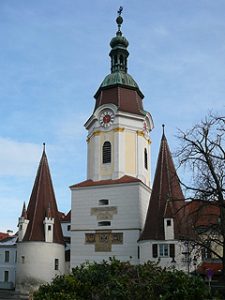
The tour of Krems starts with a model of the town that can be seen free of charge in Room 2 of Museum Krems. Thereafter a figure of eight route is followed through the old town where historic highlights are pointed out and explained. Included in this tour are developments in religous thought over the centuries: Medieval heresy, the Reformation and Counter-Reformation and the dissolution of certain monastic orders. If all items are listened to, a minimum of one and a half hours must be allowed. To open up the itinerary and start the tour click on the title above. Text: Alexander H. Curtis, all rights reserved.
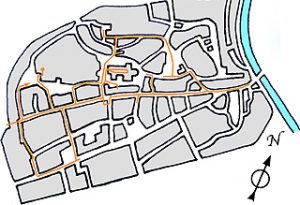
Stein Tour: Salt, Houses, a Bridge and a River
Welcome to this Reloading Humanism tour of Stein. The tour works through the use of buttons which when pressed initiate a Google Chrome plug-in. This reads the English texts. Once started pressing the button again stops the reading. Pressing the button a third time restarts the reading from the beginning. Street directions are at the beginning of each tour item so that the repetition of instructions is straightforward.
WORLD HERITAGE CENTRE
At the Shipping and World Heritage Centre an open air exhibition gives an informative introduction to the history and culture of the Wachau. Look South across the river to sees the Benedictine monastery of Göttweig. Göttweig is old German for “Where God whiles”.
A HARBOUR
From the World Heritage Centre walk inland. Using the two zebra crossings leave both roundabouts on your right and cross the Steiner Donaulände. During the Middle Ages on the other side of the second round about there was a harbour. The harbour was discovered when the silver twisted cuboid building was built. This latter is The State Gallery of Lower Austria. At the harbour and all along the banks at Stein barges could moor close to the bank. They could thus load and unload their cargoes this being something that could not be done at Krems. Nevertheless Krems lay on the North-South route that lead from Prague to Venice. Accordingly the prosperity of the two towns was linked. For this reason, although run sepeartely many decisions were made jointly.
KREMSER TOR
Continuing on up the slope and taking the first left leads to the Kremser Tor or „Krems Gateway“. This is the eastern gateway to Stein and is so named as it faces in the direction of Krems. Built in 1470, the steeply pointed roof is a Renaissance feature. Stein occupies a narrow strip of land between the steep slopes of the plateaux above and the course carved out by the River Danube. Look up to the right to see the vineyards that overlook the town.
STEINER LANDSTRASSE 14
Passing through the gateway, on the right-hand side one immediately comes to Steiner Landstrasse 14. Although the fabric of the houses on the Steiner Landstrasse date from the Middle Ages, buildings were repeatedly adapted and rebuilt over the centuries so that today, the town is largely defined by the seventeenth and eighteenth centuries. Earlier architectural fragments however abound such as here, where at Number 14 an extended bay dates from the Renaissance. This form of Late Gothic pipework was used as an adornment on doorways, window-frames and supports. Once common it is now rare.
GÖTTWEIGERHOF CHAPEL
After the Late Gothic pipework take the first right anf go through the archway. This leads to a second archway over which a Gothic chapel has been built. This is the Göttweigerhof Chapel which has an eight-sided tower. The chapel dates from the fourteenth century and so from the Middle Ages proper. As can be seen from the sign on the right hand side, the frescos that decorate the chapel, hallway and oratorium are important examples of Gothic fresco painting. The interior also features rib-vaulting and niches.
For those who can spare the time, the key to the chapel can be borrowed from Museum Krems. During the winter months (when the museum is closed) the key is available from the city’s Cultural Office which is situated above the museum on the second floor. Borrowing the key costs € 2 per person and includes a highly informative folder which is available in either English or German.
THE GÖTTWEIGERHOF
Going through the second archway brings one to the Göttweigerhof or “Göttweig Courtyard” itself. So that they would be self-financing monasteries were granted extensive areas of land. Over the centuries was then added to through wills. Like many monasteries the monastery at Göttweig owned land on both sides of the River Danube. Land was let out to tenants on a tithe basis with the monastery specifying which crops were to be grown. Once harvested the tithes were delivered to central depots where everything coming in was counted. The Göttweig Courtyard was the agricultural collecting yard for Göttweig Abbey. It was also where the farm factor lived who oversaw operations. Here, crops such as wheat and barley were stored while grapes were pressed to make wine.
Crossing the courtyard and going through a third archway leads out of the old town. Turning right and looking at the eastern wall, one can see that the outer buildings have a defensive character. As can be seen on the landward sides of the town, beyond the walls, there was once a protective ditch. Return back through the Göttweig Courtyard. At the Steiner Landstrasse turn right and carry on along the high street towards the West.
SALT STEADINGS
At Steiner Landstrasse 27 and 27a, two imposing houses form the southern side of the Minoriten Platz. In these Salzstadl or “Salt Steadings”, salt was stored prior to re-sale. Built in 1579, they testify to the importance of salt for the town. Rock salt was mined near Salzburg in an area known as the Salzkammergut and was then shipped by river to Stein. This was done using craft that increased in size as the salt was carried first along the tributaries of the River Traun and then along the Traun itself, down towards the Danube. As Krems had no access to the river for hundeds of years only Stein had the right to buy and sell salt. Although this privilge was hotly disputed, Krems was only ever able to acquire the privilage intermittently.
In 1457, following the death of the King of Bohemia and Hungry, Lasislaus Posthumus, a dispute broke out between Emperor Friedrich III and his brother, Archduke Albrecht VI. Here thedispute was about who should take over the vacant thrones. During the dispute salt was a major item of contention with Albrecht claiming the salt mines in Hallstatt and Friedrich those at Altaussee. As the dispute disrupted trade, the two villages resolved the problem by signing a treaty. For Krems and Stein however this was not an option as they were too close to Vienna. Renouncing their loyalty to the Emperor, theViennese favoured Albrecht. At first Krems and Stein followed suit. Later however the councillors decided to remain loyal to Friedrich. Thus when in 1462 the Emperor was being besieged in his castle in Vienna, the two towns ninety soldiers to support the Emperor. This tipped the balance and as a sign of gratitude, Krems and Stein were granted privileges and favours that greatly enhanced prosperity. These included the right to insist that all goods passing through the two towns be offered for sale. Goods could only proceed if no local merchant was interested in buying them. The dispute came to an end when Albrecht died soon after without an heir. Inside the Salt Steadings there are closely spaced, thick beams. These were specially designed to support the weight of the salt stored on the first floor. Salt was stored on thefirst floor as only then was it was safe from floods. On average floods happened every five years and were often a result of snow melting in the spring.
THE REBENTOR
Continuing on along the Steiner Landstrasse, pass through Ludwig-von-Köchel-Platz and approach the Church of Saint Nicholas. Before looking at this lower church, those who can should climb the steep steps that lead to the upper church. This is Lady Hill Church and it was on this rocky outcrop that the beginnings of Stein as a settled community are to be found. The first people to live here were Slavs who inhabited the Northern banks of the Danube during the Late Roman Era and the Age of Migration. The current church stands on the site of an older church that dates from the eleventh century. The foundations of this older church stand in turn on a structure that dates from the Roman era. Pass through the base of the tower and continue on to arrive at the Rebentor, or Vine Gate. Either side of the Rebentor, the town’s northern wall once extended along the length of the Kellergasse.
THE WELL
Retrace your steps back to Lady Hill Church. Alternatively instead of going straight on, you turn right and follow the narrow flight of steps down. This leads to a well from which for hundreds of years, water was drawn. Once a busy meeting point, this is now a tranquil spot where a refreshing drink of spring water may be enjoyed. From here, turn left to return to Lady Hill Church.
THE CHURCH OF OUR LADY
During the thirteenth century, even though it was not yet finished the lower church was made the official parish church of Stein. Meanwhile the upper church was dedicated to the Virgin Mary. It thus became Lady Hill Church, or the Frauenberg Kirche as it is known in German. The church’s current form derives from the 1380’ies with the interior dating from around 1470. The fabric of the tower dates from late sixteenth century and is capped by a distinctive Baroque roof. The tower has seven stories and unusually there is a chimney. This is because up until 1970, the top floor was where a watchman lived who would keep a lookout for outbreaks of fire. In 1966, the church was dedicated to the memories of those who had fallen during the First and Second World Wars.
SAINT NICHOLAS‘ CHURCH INSIDE
Go back down the steps and turn right to approach the entrance of the new church. This is the Church of Saint Nicholas which as a building is first mentioned in the fourteenth century. The current structure however dates from the fifteenth century. Built in a Late Gothic style, inside there is a kind of webbed rib-vaulting that is typical for the region.
During the eighteenth century, the church was fitted out with a dominating array of Baroque furniture. These fittings enclosed large paintings by the acclaimed artist, Martin Johann Schmit who lived in Stein. At the beginning of the twentieth century, this black and gold furniture was replaced by much lighter Neo-Gothic fittings. As a tribute Martin Johann Schmidt a large altarpiece with a painting by the artist was allowed to remain. This is located in an alcove on the North wall and shows Saint Nepomuk. A side altar on the South side of the church also features a painting by Martin Johann Schmidt. This shows the church’s patron Saint Nicholas. Reflecting the importance of the river, both altarpieces address saints who may be called upon by those in danger of drowning. Both saints are shown in the process of saving people from watery graves.
Nine other paintings in the church by Martin Johann Schmidt were sold in order to pay for the Neo-Gothic fittings. Nevertheless the pews, font and organ are all Baroque. The Neo-Gothic fittings are well-designed and masterfully executed and admirable compliment the Late Gothic architecture. The small main altar allows light from the specially commissioned stained glass windows to flow in. The pulpit is particularly gracile despite the fact that it is surmounted by an almost life-size statue of Saint John the Baptist. All this serves to re-endow the church with an airy quality that for two hundred years was suppressed.
SAINT NICHOLAS‘ CHURCH OUTSIDE
Opposite the church there is the vicarage with a Baroque façade by Johann Michael Flors. Flors was responsible for a number of façades and moulded ceilings in Krems and Stein. Turn right to see on the South side of the church’s exterior, a larger than life-size image of Saint Christopher. This dates from 1537 and was once clearly visible from the river. Saint Christopher is the saint who carried Jesus across a river despite the ever-growing weight of the cares that the Son of Man bore. He was therefore popular among the Schiffersleute or shippers, who worked on the river. The fresco shows the Saint stepping into a river with the Christ Child on his shoulder.
THE NEW TOWN HALL
Following the Steiner Landstrasse on towards the West, brings you to Rathaus Platz where the Town Hall is. Here citizens could and still can, ask for “Rat” or advice on all civic matters. The building only became the Town Hall in 1701 and is fitted with an impressive staircase and a reception room. This later features a moulded ceiling that dates from 1740/1750 and is thought to be the work of Johann Michael Flors. In 1779 the façade of the Town Hall was rebuilt by the renowned Baroque architect, Johann Michael Ehmann.
SAINT NEPOMUK
At the centre of Rathausplatz there is a three columned monument. This honours Johannes Nepomuk (1350-1393). Nepomuk was a Bohemian priest and martyr who became popular during the eighteenth century. He was martyred by being thrown into the River Moldau from the Charles Bridge in Prague. According to legend as his drowned body floated downstream, it was accompanied by flickering tongues of fire. An inversion of the circumstances of his death has thus made him a patron saint of bridges. He also offers protection against death by drowning. Built in 1715, the monument utilises the latest in Baroque illusionist technology. Suspended from the baldachin a cloud and a cherub are held aloft by a chain. Like the Virgin Mary Saint Nepomuk is often depicted with a halo adorned with five stars. Although this is not the case here, the five cherubs surrounding him hold his stars for him.
LARGE PASSAU COURTYARD
After the Rathausplatz, at Steiner Landstraße 76 there is the Großer Passauerhof. This has a Renaissance façade which is topped by dog-tooth castellation’s and miniature turrets. Krems and Stein belonged to the Bishopric of Passau and the Large Passau Courtyard was the bishop’s episcopal residence. The building was originally three Medieval houses. In the middle of the sixteenth century these were then moulded into one. Like the Göttweigerhof the courtyard was an agricultural collecting yard where a factor lived and where crops were collected and grapes were pressed.
THE TOLL COLLECTOR’S HOUSE
Continuing on along the Steiner Landstrasse leads to Schürerplatz. In the north-western corner there is the Toll Collector’s House. The Toll Collector was the person who organised the tolls that were due for crossing the bridge situated just outside the town. The house is a forgotten gem of Northern Renaissance architecture, On the ground floor the most noticeable features are the columns that support the bay-window. These derive from a tradition that, lacking an in-depth acquaintance with the Greek orders of architecture, did not distinguish between genuine Roman capitals and their Romanesque descendants. As can be seen this misunderstanding lead to an innovative and unrestrained approach and a unique style of northern Renaissance architecture.
Higher up, enclosed in the ends of the scrolls that hide the gable ends, there are portraits of Emperor Ferdinand I and his wife, Anna. Above the windows of the two-storey bay-window, there are the arms of Ferdinand and the imperial crown and eagle of Austria. Higher up a cherub holds a tablet with an inscription that reads: Jupiter in coelis Caesar regit omnia terris 1536. This translates as: Jupiter, the heavenly Caesar rules all Earth 1536. Above the first floor window, a second inscription reads: Verbum Domini manet in aeternum ex. This is taken from Isiah 40:8. Here the prophet says: The grass withers and the flowers fade but the word of the Lord endures for ever. On the Toll Collector’s House the inscription only gives the second phrase. The emphasis on the Word of God suggests a Protestant inclination. The inscription above implies humanist learning. This interpretation is supported by the building’s other decorative elements which consist of dolphins and floral motifs. These are typical for the Renaissance and derive from a style of decorative, ornamental painting known as grotesque. This was a form of ornamentation that going beyond the strictly ornamental, was alive with interconnected elements. Flowers for example were linked with such things as masks, singing birds and dolphins.
HOLZINGER HOUSE
Continuing on along the Steiner Landstrasse at Number 90, there is the Holzinger House. This was built by Christoph Holzinger between 1595 and 1599. Over the entrance a relief shows a knight in armour who holds a chalice. Below him the key-stone shows Holzinger’s coat of arms with a lion and a griffin on either side as supporters. The letters CHVL stand for Christoph Holzinger von Linz. Holzinger’s coat of arms were bestowed on him by Emperor Rudolf II for his services in the wars against the Turks. After retiring from the army Holzinger administrated the Salt Office in Krems and Stein. In 1605 he was elevated to the nobility and awarded a second coat of arms which is shown on the keystone of Number 88. This house was bought by him in 1608. At Number 90 the fragmented frescos on the façade date from between 1540 and 1580. These show Saint Florian, the patron saint of fire-fighters and Lucretia. Both figures are accompanied by verses that can no longer be reconstructed. Saint Florian chose to die as a martyr rather than renounce Christianity. After she had been raped Lucretia chose to die rather than live as one defiled. Here one can see that the confident vivaciousness of the Renaissance is beginning to fade. A limpness has begun to set in which is matched in religion by the dogmatism and intolerance of the Counter-Reformation. In view of Holzinger’s rapid career, it is unlikely that he was a Protestant.
THE GREEN CASTLE
At Steiner Landstraße 92 there is the Karlingerhof which is more commonly known as the Green Castle. This dates from the same period as the Toll Collector’s House but is built in a Late Gothic style. Although the house appears Medieval, look carefully at the remaining fragments of decoration. These show influence of the grotesque style of decoration that was very much en vogue.
J. M. EHMANN PLATZ
Continuing on along the Steiner Landstrasse leads to Johann-Michael-Ehmann Platz. Here there is a Baroque statue of the Virgin Mary, flanked by Saint Sebastian and Saint Rochus. Apart from re-designing the façade of the Rathaus in Stein, in 1786 Ehmann was awarded the commission of re-building the church and monastery at Maria Langegg. Located on the other side of the river in the Dünkelsteiner Wald, during the seventeenth century, Maria Langegg was a place of pilgrimage. In times of plague the citizens of Stein would journey to the monastery.
BATHING JESUS AND MOORING RINGS
After the statue at Johann-Michael-Ehmann Platz turn left down towards the river. On western side of what was once a gateway there is a relief known as „Bathing Jesus“. This refers to the fact that floods often subjected the depiction of the crucified Saviour to a partial and sometimes total immersion. As the florally-derived decoration is related to that on the Green Castle this alienated and transposed fragment can likewise be assumed to date from the Renaissance.
On the other side of the street, at Steiner Donaulände 90, a mooring ring for barges may be seen. A second ring may also be found at Number 88. Up until the nineteenth century the Danube was where the Steiner Donaulände is now. As the rings testify mooring was simply a matter of approaching the bank and making fast.
BAILONI
Returning to the Steiner Landstrasse at Number 102, there is the schnapps distiller Bailoni. The Bailoni story begins when Eugenio Bailoni met Rosa Amon whilst travelling in Austria. Romance blossomed and the distiller’s son soon found himself moving to the Wachau. Once there he realised that the apricots for which the region was so famous, could be fermented and distilled. In 1872 the First Wachau Apricot Distillery was established and has flourished ever since.
A LATE GOTHIC BAKERY
At Numbers 106 and 108 there are two houses with Late Gothic window frames. Number 108 dates from 1500. As can be seen from the ends of the stone beams that support the protruding first floor, the house was once a bakery. The emblems shown are a baker’s products and include a loaf and a distinctive pretzel.
M. J. SCHMIDT HOUSE
Steiner Landstrasse 122 is the house where Martin Johann Schmidt lived and worked. In the window there is the plaster portrait of the artist from which a bronze statue was made. Martin Johann Schmidt was pious and the house includes a private chapel. Martin Johann Schmidt was famous for painting large pieces. In order to have the space to execute these he had the floor of the second story removed. This has however since been replaced.
LINZER TOR
As it faces in the direction of Linz this gateway is called the “Linzer Gate”. Parts of the city-wall that once enclosed Stein date from the thirteenth century. The Linzer Tor in its current form however mainly dates from 1477. This was when following an unsuccessful siege the town’s defences were upgraded. Eight years later the Hungrian king Matthias Corvinus, again encroached upon Austria territory and once again failed to take Krems and Stein. Surmounting the Linzer Tor there is a charistically Baroque, mansard roof. Meanwhile the clock defies convention by having a minute hand that is short and an hour hand that is long.
THE BRIDGE
Passing through the gateway, on the northern side there is the Danube Private University. The building was once a school but is now where all aspects of dental medicine are taught. On the southern side there is a park named after Ernst Schandl who composed a number of well-known songs that celebrate the Wachau.
From the Ernst Schandl Park, a clear view of Mautern Bridge may be seen. The village of Mautern, on the other side of the river, derives its name from the word “Maut”. „Maut“ means “toll” and crossing the bridge was subject to a toll which was collected by the Toll Collector. The bridge owes its origins to the 1457 dispute between Emperor Friedrich III and Duke Albrecht VI. Among the various privileges granted to the Krems and Stein was the right to build a bridge across the Danube. There then followed decades of debate about where the bridge was to be sited and how the challenges of the undertaking were to be tackled. Finally at the end of the fifteenth century, a wooden bridge with nineteen crossbeams was built. This was known as The Wooden Gate.
At the end of the nineteenth century the Wooden Gate was replaced by a bridge made of iron. Of this structure only the northern half is original. At the end of the Second World War retreating German forces blew up the southern half so as to delay the rapidly approaching Red Army. Due to its importance, the missing sections of the bridge were rebuilt in just over two months. This was overseen and directed by engineers of the Russian army with prisoners of war being conscripted for the manual work. The re-built bridge was opened by Field Marshal Iwan Stepanowitsch Konew and the Austrian Chancellor Karl Renner. At the southern end plaques in Russian and German attest to the re-building. After 125 years, the bridge is in need of refurbishment and will be back in service in 2027.
FLOOD LEVELS
From the Ernst Schandl park a flight of steps leads down towards the Steiner Donaulände. At the bottom of the steps a granite plaque shows the levels of the major floods from 1740 up until 2002. Prior to the building of flood defences floods were to be reckoned with every five years. This was either as a result of the winter snow melting in the spring or as a result of heavy thunderstorms in summer. For this reason the ground floors of houses in Stein were never for living in. Instead they were used for storing things that could quickly carried up to the first floor in the event of a flood. In well-to-do houses the ground floors also served as impressive entranceways.
THE CASTLE
From the steps turn left and using the zebra crossing cross the Donaulände. Then go down into the underpass to cross the B3. From the underpass turn left and follow the towpath back East towards the World Heritage Centre. Above the Linzer Tor there are the remains of a small castle. This marks the western end of Stein’s defenses. During the Renaissance the fortification was also a small palace. This was destroyed by Swedish troops during the Thirty Years War. The Thirty Years War was fought between 1618 and 1648 and was one of the most destructive conflicts in Europe. As a result battle famine and disease it is estimated that some 4.5 to 8 million people died. Prompted by the deposition of the king of Bohemia the war was fuelled by the differences between Catholics and Protestants within the Holy Roman Empire. As the conflict wore on however it became a contest for the domination of Europe. Here the contenders were the Habsburgs who controlled Spain and Austria and the Bourbons of France.
A POND AND A PROMENADE
For hundreds of years the northern banks of the Danube were where the Donaulände is now. When the river froze ice broke into large blocks and thick sheets. These were then pushed by new layers of ice up and out of the river. Pushed towards the houses the ice was capable of causing considerable damage. To prevent this in 1890 a dam was built. At first this ran from above the Mautner Bridge down to Johann Michael Ehmann Platz. The dam was then extended to the railway bridge which lies downstream of the World Heritage Centre. The dam created a long pond which was quickly filled in to create a road and a promenade. The pond and extended bank served as a buffer where the ice pushed up by the river could accumulate. In 1954 work started on the B3 that runs along the Wachau from Krems to Melk and the road being opened four years later.
WALLS AND DEFENCES
Looking across the road one can see that the towers and houses have thick walls. The towers also have loop-holes for shooting out of. Following the unsuccessful sieges of Krems and Stein in 1477, the walls of both towns were made thicker so as to be able to withstand bombardment by more destructive artillary. Towers were built so as to protrude further out, so that defenders could shoot more accurately at those who would scale the walls. As Matthias Corvinus found out in 1485, these measures were highly effective. And again the Hungarian king was unable to capture either Krems or Stein.
Originally closed off from the river the four squares that are characteristic of Stein were only opened when the walls were no longer needed. At Schürerplatz immediately to the West of the tower there was a gateway known as The Fishers‘ Gateway. On the otherside of the tower the square was closed by the town slaughterhouse. This was only pulled down at the end of the nineteenth century. Near the south-eastern corner of the square there is a bronze statue of Martin Johann Schmit, the plaster original of which has already been seen.
FISH AND FISHING
The first laws regulating fishing on the Danube were drawn up in 1506 under Emperor Maximillian I. The laws identified seven „noble“ fish. These were the pike, carp, barbel, Danube salmon, burbot, catfish and trout. The first fishing regulations that specifically refer to Stein date from 1579. Fishing as a commercial activity in the town is recorded from this time on up until 1809. It was understood that overfishing the smaller fish would ultimately reduce the populations of larger fish. The regulations therefore restricted the fishing of all kinds of fish. In Stein fishermen and fish-mongers sold pike, carp, eels, trout, chor, common gudgeon and European bullhead or miller’s thumb. As elsewhere, on the Danube most of the fishing techniques used involved nets which if not fixed with poles to the river bed were either raised or drawn through the water. Today there is only one profession fisherman in Austria, who fishes the Danube at a variety of locations.
In Lower Austria there are today sixty-four different kinds of freshwater fish. Twenty-nine of these are either endangered, strongly endangered or are by ways of becoming extinct. Another nine are at a critical level and the eel is already regionally extinct. Ten kinds of fish are not indigenous but were introduced to Lower Austria by human beings after 1492. From the tributries of the Danube fish that are less well adapted to the deeper waters are washed down and may be found as rarities. A recent new-comer is the Black Sea gobie which clings to the bottoms of ships with suckers. Over the last twenty years this fish has become a permanent feature of riverbed fauna. In the Lower Austrian reaches of the Danube the following fish are common: bream, white bream, vimba vimba, crucian carp, pussian carp, barbel, rudd and roach. Less frequently occurring but not necessarily endangered are: pike, the wels catfish, the brown bullhead, tench, ide, common dace, chub, rutilus virgo, white-eyed bream, zope, schneider, bleak, aspius aspius, common nase, gras carp, Danube ruffe and European perch.
A LOST WAY OF LIFE
Continue walking eastwards along the towpath and try to imagine a very different River Danube to what we see today. Along with this there was a very different way of navigating the unregulated and dangerous waters. Prior to the introduction of steam shipping, conveys of barges were laboriously hauled upstream by teams that could involve anything up to a hundred men and horses. The towpath was neither extensive nor permanent. Along most reaches of the river there were long stretches where there was no path. Instead there was a treacherous patchwork of ox-bow lakes, bogs and wet-patches. At the front of a convey there was a lone figure mounted on a horse. With a pole this Wagehals or dare-devil, would try to sound out the way ahead. Sometimes all that one saw of the dare-devil was the head of his horse and the head and shoulders of the rider.
The horses were shire horses. Arranged in pairs each pair had a driver who rode on one of the horses. Apart from being strong the horses were specially trained so as to be able to jump into barges. They were also trained to wade through water and not get caught in the 60 metre long hawsers that they pulled. A convey typically consisted of three freight barges. In front of the three barges there were smaller boats with short stubby masts. It was over these masts that the tow-rope was hung. This was so as to prevent it from touching the water. At sea the dried salt prevented ropes and cordage from rotting. Inland hoever this was not the case and fresh water quickly rotted ropes made from natural fibres. Conveys were often 500 Metres long. After the freight barges, there followed the supply ship and the galley-boat. Here where a team of cooks worked hard to cater for the crew and riders.
HORSE-DRAWN RIVER TRAFFIC
For the 450 Kilometre journey from Vienna to Regensburg a horse-draw river convey would need between six and eight weeks. Starting and stopping were time-consuming processes. When it was necessary to change from side of the bank to the other, the operation could take a whole day. Where passage upstream was slow and laborious, progress downstream was a process of controlled drifting achieved through the use oars.
During the first half of the nineteenth century some 850 barges were floated downstream to Vienna every year. This contrasts markedly with the mere 350 were pulled upstream. This was because the costs of a convey were such that barges were seen as being semi-disposable and empty barges were never pulled upstream. Wherever possible rafts were used. Timber was transported on rafts that were made using the timbers to be transported.
A LINGUISTIC LEGACY
The shippers were gregarious. During the winter when no shipping work could be undertaken, they would spend their time in taverns. They would also work on preparations for the carnival that concluded the winter period. For some linguists, the word carnival derives from the Latin, vale carne. By bidding farewell to the eating of meat, this Latin phrase announces the arrival of Lent. Yet for other linguists, the word carnival derives from, carrus navalis. This is again Latin but this time refers to a ship-cart or float. This was pulled through the streets and was followed by a procession of boatmen dressed as fools. These ferstivities is took place when the ice and snow of winter began to thaw. This heralded the time when the shippers could once again take to the river. Accordingly among women the advice was: Never marry a shipper, in the summer you’ll have no husband, in the winter you’ll have no money.
A PORTICOED LANDING-STAGE
Proceed onwards until you see a house with a portico on the otherside of the Donaulände. The building was once an inn called the Gasthaus zum Elefanten. This was because in 1551 an elephant named Solomon and his mahout, Subhro spent a night here. The elephant was a wedding present from the king of Portugal King João III, to Archduke Maximilian of Austria. Solomon and Subhro walked all the way from Portugal to Vienna. Everywhere the elephant and his mahout went, the great beast was seen as a marvel. Inns and hostels where they stopped, recorded the event by renaming themselves with such names as, The Elephant’s Rest and the Elephant’s Guest House.
Leading away from the portico out into the Danube, there was once a landing-stage. Here in 1762 Mozart and his father and brother alighted from a barge and spent a night. Arriving in Vienna, the precocious siblings were presented to Viennese society and performed to rapturous applause.
Ten years later, in 1772 the English musician and music historian, Charles Burney travelled through Austria, Germany and Bohemia. In Krems and Stein he enthused at the high level of musicality that he found in both towns. One evening from a barge on the river, he chanced to hear four women singing privately in a house in Stein. In his diary he was struck at the competence with which the four voices of the polyphonic composition were sung. In Krems he observed that „undistinguished citizens in taverns and farmers at work in the fields, will sing for pleasure, songs in two more voices“. Confirming the high level of musicality in the region are the organ and violin-makers in Krems. After the turmoil and destruction of the Thirty Years War these specialist instrumt-makers were able to re-establish themselves. From the eighteenth century onwards a living could be made from the making of high quality instruments.
LUDWIG VON KÖCHEL PLATZ
The end of the house with the portico forms the western side of Ludwig-von-Köchel-Platz. This is named after a scholar who was born in Stein in the Großer Passauerhof in 1800. During the first half of the nineteenth century Mozart’s prodigious output was uncatalogued. It was not even known how many works the composer had written. The awesome challenge of addressing of this gap in musical scholarship was taken on by Ludwig von Köchel. First published in 1862 the Köchel-Verzeichnis or KV as it is known, catalogues all known works by Mozart. Still to this day is used by scholars throughout the world.
THE REGULATED DANUBE
Continue on eastwards towards the World Heritage Centre. The regulated Danube of today is a far cry from the wild and uncontrollable Danube of yesterday. For thousands of years the river had meandered this way and that across a huge flood plain. The story of the regulation of the Danube is the story of mechanised shipping. This begins in 1829 when The First Royal and Imperially Warranted Danube Steamship Company was formed. A year later the first steamship set out from Vienna and arrived in Budapest 14 hours later. Not surprisingly the return journey took 48 hours. Nevertheless the trips were a sensation and the venture was considered such a success that a regular service was established. From the 1850’ies onwards the demands for steamships and faster travel lead to nearly all Austrian reaches of the Danube being regulated. Rapids and cataracts were dredged and outcrops of rock were blasted away.
The first steamships carried people. By the 1870’ies however the river was regulated enough for steam-powered freight shipping to undermine traditional barge transport. As a result thousands of shippers were deprived of their livelihood. This in turn had major consequences for the economy of Stein. Suddenly there were no longer shippers staying at the town’s pubs and inns. Between 1665 and 1839 there had always between seven and nine inns in the Stein but steam shipping this dropped dramatically. The trades associated with traditional shipping were also rendered superfluous. Accordingly prosperity in the town plummeted. To keep the newly regulated reaches navigable, ships would drag specially constructed ploughs along the bed of the river. With the introduction of the internal combustion engine, the amount of people required to operate a ship was further reduced. Today freight ships are manned by two or three people. Yet the cargo carried is comparable to and often exceeds, the tonnage carried by a traditional horse drawn convey of three barges and a hundred men. Nevertheless the old Danube lives on in words and maps. On the map, the old river reveals itself and its once meandering course can be reconstructed via abandoned side-arms, oxbow lakes and place-names.
END OF STEIN TOUR
Dürnstein Tour: A Tale of Two Castles, Two Monasteries, Saffron and Wine
Welcome to this Reloading Humanism tour of Dürnstein. The tour works through the use of buttons which when pressed initiate a Google Chrome plug-in that reads the English texts. Once started, pressing the button again stops the reading while pressing a third time restarts the reading from the beginning. Street directions are therefore at the beginning of each tour item so that the repetition of instructions is straightforward.
A NORTHERN FRONTIER
From the landing stage walk westwards towards the town along the river bank. For the Romans, the Danube was a natural barrier that hindered the North-South movement of people. The river was thus an integral part of the Roman Empire’s northern frontier. Downriver from the landing-stages, the rocky cliffs of the Hoehewand or High Wall can be made out. These force the river to turn East. From here the river runs south east, meandering through flat plains that run all the way to Vienna. At the foot of the cliffs, there are the remains of a Roman signalling station. This was once part of a series of towers that ran the whole length of the Wachau. From the South side of the river, a river-eye view could be kept on the northern banks. This was where uncontrolled Germanic tribes lived. Signals sent in times of danger were passed on from tower to tower, to a fort down river. This was at Mautern. Only a few miles away, Mautern was where a thousand solders were stationed.
A ROMAN SUPPLY ROAD
Continue walking upriver as far as the first turning to the right. Much of the Wachau’s southern bank consists of un-scalable cliffs. There was thus there was no need for the Romans to build a continuous wall. At that time, below the cliffs, there was no space for a road along the river bank. The isolated forts and watchtowers were therefore supplied from a road above. This ran along the hills that form the skyline. Access roads then lead down to the river-side outposts. On steep slopes, the engineers would cut grooves into the rock. This was so that the iron-bound cart wheels would not slide about. Further downstream, in more settled regions, the Danube was used as a waterway. Going upstream, ships were pulled by teams of slaves.
THE SLAVS
As you approach the town, look to the right to see the eastern walls and the famous castle above. In between the river and the landing stage, there are vine-yards. The first people to settle permanently on the northern banks were a people known as Slavs. The Slavs settled on the northern banks during the later years of the Roman Empire. From this time on, up until the tenth century AD, they lived in small hill-top settlements. Whether the hills above Dürnstein were settled in this manner is unknown. It is however a perfectly feasible scenario.
THE SETTLING OF THE WACHAU
Driven away in the tenth century by invading Magyars from Hungary, the Slavs never returned. Apart from place-names, all that remains of their presence are skeletons and artefacts. After driving away the Slavs, the Magyars pressed on into southern Germany. Approaching Augsburg, they were defeated in 995 AD, at the Battle of Lechfeld. After this battle, a program of settlement in the Wachau was initiated. This was at the behest of the soon to be Holy Roman Emperor, Otto III. Otto allocated areas of land to German monastic institutions so that they might cultivate it. This was designed to attract craftsmen and traders. In this way, the establishment of law-abiding communities was aided and abetted. Highly effective, it was this policy that made the Wachau look the way it does today.
WINE CELLARS
At the first metalled turning to the right, follow the gently sloping path up. Either side of the path there are entrances to wine cellars where wine is made and aged. In Otto III’s decree, it was noted that the area was suitable for wine-growing. The monasteries were endowed with more land than the monks themselves could farm. Accordingly, significant tracts of land were leased to tenant farmers. Instead of paying rent, these farmers paid a tithe of what they produced. This was important as it enabled the monks to concentrate on wine-making.
WINE-MAKING
Medieval monks acquired considerable expertise in all aspects of wine-making. Over the centuries, they established step by step, the principles of modern day viticulture. To ensure that quality was maintained, local representatives were appointed. The representative then oversaw all aspects of the wine-making process. Little is known of what grapes were used. Nevertheless in 1301, Riesling grapes are recorded as being used in the Wachau. In around 1400, it is recorded that in Dürnstein, Muskateller grapes were grown. At this time, vines grew up and around poles that were inserted into the ground.
THE CASTLE BEGINNINGS
Follow the path up until you arrive at a metalled road. To the left there is the Steiner Tor. This is the gateway that leads into Dürnstein from the eastern side. The first gateway was built in around 1192. What you see now dates from the fifteenth century. Before going through, pause to look up at the castle and back out over the vine-yards. After Otto’s death, Henry II continued the policy of settling the region. In 1002, Henry gave areas of the Wachau to the Tegernsee Monastery in Bavaria. To act as stewards of their Wachau estates, the monastery appointed the Kuenringer. This was an aristocratic dynasty with retainers of armed men. In this way law and order were ensured. During the middle of the twelfth century, Hadmar I of Kuenring built two castles in the area. One was the castle at Aggstein only a little way up river. The other was the castle at Dürnstein. Both castles were built on rocky pinnacles, with commanding views of the river.
THE CHURCH OF SAINT KUNIGUNDE
Go through the Steiner Gateway and turning right. Turning immediately right again, climb a short flight of steps. Open a wrought-iron gate to enter a cemetery with two buildings. This cemetery is where Dürnstein’s first church was located. The first church will have then been replaced by a later structure. Of this later structure, only the tower and sacristy now remain. These are Romanesque in style and date from around 1200. On the eastern face of the tower, the roof line of the original nave can be made out. In 1220, the church was recorded as being the parish church of Dürnstein. Dedicated to Saint Kunigunde, the nave and apsis were pulled down in 1783.
THE CHURCH TOWER
On the South side of the tower there is a doorway. This features a style of Late Gothic piping which was typical for the Wachau. The doorway can thus be dated to the fifteen century. For hundreds of years, church towers were watchtowers. These were manned by a lookout. When brigands or the troops of a marauding army were sighted, the bell was rung. In times of peace, the lookout’s duty was to watch for signs of fire. It is from such a tower that the Wachau gets its name. The word is an abbreviation for die Wache in der Au or, the watch tower in the marshes.
THE OSSUARY
On the other side of the cemetery there is an ossuary, or charnel house. Here the exhumed bones of people buried in graves are kept. This was so that once bodies had decomposed, the grave plots could be re-used. The ossuary is built in a simple Gothic style and dates from the fourteenth century. The fabric of the walls may however be older.
THE CASTLE: A PROMINENT GUEST
From the cemetry, look up towards the castle. Forty years after it was built, Dürnstein Castle was where a famous guest was detained. This was Richard the Lion Heart. Whilst leading the Third Crusade, Richard gravely offended Leopold V of Austria. Returning from the Holy Land in 1192, Richard was forced by a storm to land at Venice. From there, he had no choice but to travel though Austria. Travelling in disguise, he was recognised as he approached Vienna. Captured, he was held to ransom. As detaining a crusader was against public law, Pope Celestine III excommunicated Leopold V. But Leopold was unrelenting.
THE CASTLE: AN ADVENTEROUS ROUTE
To visit the castle using a steep route, return back down the steps and turn right. This was the path along which everything needed was carried up to the castle by donkies. The route follows the eastern wall through overgrown vineyards. As you go, look to the right to see how the walls utilise the rock formations. A third of the way up there is a view of the town. On the left is the Clarissine Convent. In the middle, the Augustine Abbey and to the right, the New Palace. On the other side of the river, on the right-hand side, there are the Prinzenau Wetlands. All these four features will be covered later on. At the top of the slope, there is a working vineyard. After the vineyard, you enter a fore-court of the castle. The entrance to the main complex is after this on the left-hand side. For just the castle, you must allow at least an hour and a quarter for a round trip with viewing. If you decide to go to the Tarbor higher up, you must add on an additional three quarters of an hour, making two hours for the whole excursion.
THE CASTLE: A GENTLE ROUTE
To visit the castle following a more gentle route, from the church, return back down the steps. Then turn left and left again and go back through the Steiner Tor. Turn left a third time and follow a more gentle slope upwards. Along the way, illustrations tell the stroy of Richard’s adventures in the Holy Land. Introducing the main characters, they then tell the gripping story of his capture, ransoming and death during his last adventure. Further up, look to the left to see how the walls have been built so as to utilise the rock formations. At the top you arrive in a fore-court. Cross over to the other side and turning right, then turn right again to enter. For just the castle, you must allow at least an hour and a quarter for a round trip with viewing. If you decide to go to the Tarbor higher up, you must add on an additional three quarters of an hour, making two hours for the whole excursion.
THE CASTLE: NO CLIMBING AT ALL
From the church, return back down the steps. Then listen to the castle items in the vicinity of the Steiner Tor.
THE CASTLE AND THE CITY WALLS
At Dürnstein, Richard was the reluctant guest of Hadmar II. After a few months, he was handed over to the Holy Roman Emperor, Henry VI. In order to regain her son’s freedom, Elanore of Acquitaine had to raise 23 tonnes of silver. Meanwhile Richard was forced to agree to a host of political concessions. Leopold used the money wisely. In Vienna he established a mint and had walls built around the city. Further South, he built defensives against the expansively minded Hungarians. Also with the money from Richard’s ransom, in Dürnstein, the town was fortified. On both sides, walls were built that ran from the castle downwards. At the river they were joined a southern wall. The whole thus formed a triangle. At each lower corner, there was a gateway. On the steep slopes above the town, there were never houses. Instead, the land was terraced and cultivated with vines.
A CELLAR AND THE CASTLE CHAPEL
At the top of the castle, on the left there is a cellar carved into the rock. It is tempting to think this was the dungeon where Richard was held but this was not the case. Rather the King of England was detained in rooms that befitted his status. Nevertheless he was under house arrest. Going past the cellar, turn right to enter the remains of the castle chapel. This was dedicated to Saint John the Evangalist. Difficult to date precisely, the chapel is not mentioned until 1306.
THE TARBOR
Return back down to the entrance. Instead of turning left and going back into the fore-court, turn right and go though an archway out into the woods. Follow the route indicated by the green markings. This leads up a stepped pathway formed from large stones and slabs of rock. After a fifteen minute climb, the path reaches the brow of the hill and forks. Turn right towards the South to approach the upper castle.
The upper castle is a small fortified house that dates from the fifteenth century. In 1476 Dürnstein was granted a coat of arms by Emperor Friedrich III. These show the town, the lower castle where Richard was imprisoned and the upper castle where you are now. Known as the Tarbor, the upper castle is assumed to be contemporary with the coat of arms. It would seem that around this time the lower castle was also modernised. This was fortuatous as the next year, Matthias Corvinus became King of Hungry and immediately invaded Austria. Laying siege to the neighbouring towns of Krems and Stein, he was repelled. As winter was apporoaching, Friedrich was able to sign a truce to end the invasion. He then ordered numerous towns and castles in Austria to modernise their defences.
THE LATER FATE OF THE CASTLE
From the Tarbor, return back to the Upper Castle. The highly ruinous state of the complex is a result of the Thirty Years War. In 1645, the castle was captured and occupied by Swedish troops. When the Swedish moved out, they destroyed the defences. In 1662, although the castle was uninhabitable, it was still maintained. In 1679 however, it was so ruinous that it was abandoned completely. Nevertheless, it was used during The Second Turkish Invasion of 1682. Here people sought refuge from marauding Turkish troops. Although the chapel had been left intact, it was unstable and in 1715 was pulled down.
RETURNING TO THE STEINER TOR
If you came up following the gentle route you may wish to descend along the steeper route. You will however need proper shoes and the route is more strenuous on the knees. If you came up the steep way, you may wish to return along the more gentle route. This takes you down on the other side of the eastern walls. Along the way, illustrations tell, in reverse order, the story of Richard’s life and adventures. The kings and queens involved in the crusades and in his ransoming are also introduced. On a sharp bend two thirds of the way down, there is a depiction of Dürnstein’s coat of arms along with the Tarbor. The depiction looks like it is a perspective rendition. It is however a collage and only the relative heights of the buildings is correct.
THE CLARISSINE CONVENT
Re-enter the town through the Steiner Tor, and turn left. This leads to the body of a large, no longer used church. This is the Church of the Clarissine Convent. The Clarissine Convent was founded in 1289 by Leutold I of Kuenring. Following the ransoming of Richard the Lionheart, a period of prosperity set in. Trade, wine-growing and farming all flourished. As a result, a number of churches and monasteries were founded. By founding churches and monasteries, rich people sought to safeguard their souls in the afterlife. They also demonstrated faith in God and showed how wealth could be beneficial to all.
THE CLARISSINE CHURCH ROOF
Although the Clarissine Church appears roofless, behind the walls there are pitched roofs. The church was not however, originally designed like this. Instead it once had a large and prominent roof. Disbanded in 1571, thereafter the convent was no longer in use. Instead it was used for storing grain. Taking advantage of this, the Provost of the next door abbey had the large roof removed. This was because it distracted attention away from his own church. Meanwhile the apse became a chapel, which however, is not open to the public.
THE ENTRANCE TO THE AUGUSTINE ABBEY
From the Clarissine Convent Church, turn to the right. Approach the sumptuously decorated Baroque entrance before you. This is the Augustine Abbey. The origins of the Abbey date back to 1317 when Elisabeth of Kuenring founded a chapel. This was dedicated to the Virgin Mary , Saint Andrew, Saint Lawrence and All Saints. Then in 1410, her heir founded a monastery. This was Otto of Maisau. The monastery was built around the chapel. From Trebon in Bohemia, Augustine Canons were then summoned. The fabric of the Abbey as it stands today was not built until the fifteenth century. By the beginning of the eighteenth century, these buildings were in a poor state of repair.
THE AUGUSTINE ABBEY COURTYARD
Go through the entranceway into the courtyard. Still owned by the Augustine Canons, the monastery is not a working monestary. This means that it can be visited. The shop, entrance and ticket office are to the right. In 1710, a new Provost of the Augustine Abbey was elected. This was Hieronymus Übelbacher, who was Provost from 1710 up until 1740. During his time as Provost, Übelbacher completely re-shaped the Abbey. Securing funding from Rome, he initiated a program of revamping without rebuilding. Cleverly adapted, the medieval buildings of the entranceway and courtyard were given Baroque façades. This was the work of the architect and builder, Jacok Prandauer. The entrance to the church, the base of the tower and the church interior were also re-vamped. This however, was the work of another architect, Matthias Steindl.
BACK TO THE RIVER
Leaving the courtyard of the Augustive Abbey, turn sharp right. Then follow a small lane and tunnel down to the river. This is the Traunergassl. Before the tunnel, on the right-hand side, there is a Gothic depiction of the Mary and Jesus. At the river, turn right again and walk along the river bank.
THE AUGUSTINE CHURCH TOWER
Look up at the Abbey above and its tower. Under Übelbacher’s guidance all elements of the re-vamped Abbey were co-ordinated. This testified to the glory of God and showed the meaning and beauty of life on Earth. Christ was seen as linking Heaven and Earth, God and mankind. Demonstrating this, the tower reaches up to the sky. It is also decorated with relief’s that show the Passion of Christ. These are the events that immediately preceded the Crucifixion. Through his suffering, Jesus was able to re-connect that which had become dis-jointed. As the sky is blue and white, these were the colours in which the tower was painted. Übelbacher was determined that saw that nothing else should compete with the tower. Accordingly, it was he who had the roof of the Clarissine Church removed.
THE NEW CASTLE
Continue on along the river. After the Abbey, look up to catch glimpses of an impressive beige and red building. This late Renaissance structure was built by Christoph of Zelking in around 1620. To distinguish it from the castle and palace above, this building became known as the New Palace. The rocks on which the Abbey and the New Palace stand were formed through erosion over thousands of years. Lookout for a stairway that leads up through the rock to the New Palace. Now a hotel and restaurant, the steps lead up to a terrace where meals can be enjoyed looking out over the river.
ERNST RUDIGER VOM STARHEMBERG
In 1663, the Old and New Palaces, along with large tracts of land, were acquired by Ernst Rudiger von Starhemberg. Twenty years later, Starhemberg was the commander of the troops defending Vienna during The Second Turkish Invasion. The siege was raised in 1683. Staying at the New Castle in Dürnstein, this was where Emperor Leopold I first heard the news. With much relief he will have heard how a coalition army had routed Turkish forces. Had the city been captured this would have had huge, incalculable consequences.
THE SECOND SIEGE OF VIENNA
Invited to surrender, Starhemberg had declined, sure that relief was on its way. Since the 1190’ies, the walls of Vienna had been modernised and had proved highly effective. Yet Starhemberg knew Turkish sappers were hard at work undermining them. With gunpowder, it was only time before the walls would be breached. Outside, one hundred and twenty thousand Turkish soldiers were waiting. But then the unexpected happened. From the hills above, the Turkish saw a coalition army descending upon them. Panicking, they began to flee and a mass retreat became unstoppable. Yet had look-outs been posted on the hills around Vienna, things would have been different. For then the Turks would have known that the Christian army numbered only eighty thousand. During the mass flight, the Turkish general and his staff paused. On a cushion, the general was handed a silken rope. Disgraced, this was so that he could hang himself.
A TUNNEL
As you walk along the riverbank, on the right-hand side you will pass a tunnel. This is the northern end of a by-pass that keeps the traffic of the busy S5 road out of Dürnstein and out of sight. From here, keep walking along the river until you come to a zebra crossing.
AN EAST-WEST WATERWAY
The wine produced by the monastery vineyards was sent back to the parent institutions in Germany. This took place via teams of men and horses laboriously pulling barges upriver. On the return journey, salt was carried downstream. This came from Hallstadt and was shipped in small craft along the River Traun to Linz. There it was transferred to barges before proceeding on down river. In like manner, ironware was shipped down the River Enn to the Danube.
THE PRINZENAU WETLANDS
On the other side of the river there are the Prinzenau Wetlands. Originally, vast stretches of the Danube will have looked like this. Where the river was free to meander, instead of there being one channel, there will have been many. These were separated from one another by wooded islands and boggy patches. Over time, the river meandered this way and that. With steam shipping however, all this changed. The river was regulated, rapids were dredged and obstructing rocks were destroyed with dynamite. Upstream, immediately before the river bends left, there is a hill that orginally stuck out into the river. As this hindered shipping, the nose of this hill was blasted away. Following regulation, over the years, the Prinzenau islands become cut off from the river. Recently however, the waterways have been re-opened. This is important as it allows fish and other aquatic animals and insects to breed. The value of wetlands as sponges that soak up flood water and reduce flooding elsewhere, is also now understood.
THE WESTERN GATE
At the zebra crossing, cross the road and then turn half right so as to follow the smaller road up. As you pass the villas on the left-hand side, look out for the remains the town’s western gateway. This was called the Weissenkirchen Tor. The Steiner Tor faces in the direction of the town of Stein. This gateway faces in the direction of Weissenkirchen, which the next town upriver. At the top of the slope there is the entrance to the New Castle. Despite a long history, much of the original fabric of this late Renaissance building is still intact.
THE HIGH STREET
Walk along the length of the high street, pausing to look at the old houses. Many houses have plates on them with the date of the last re-building. Most houses are Renaissance and later. Nevertheless, the underlying fabric is often much older.
WIESER
In Austria, home distilling is legal and was once widely practised. After abandoning the beginnings of a degree in law, Markus Wieser became interested in distillation. The grandson of a well-known wine-grower, he began by experimenting with his grandfather’s still. After all manner of experiments, he arrived at a trio of distilled products. These are apricot schnapps, gin and whisky. For those wary of what one might call, distiller’s fire, reassurance can be given. Wieser’s schnapps is smooth and well-rounded. In addition he and his wife process apricot kernels and make chocolate, jams and beauty products. With two outlets in Dürnstein and others elsewhere, the Wiesers are difficult to oversee.
Between April and October, the Dürnstein outlets of the Wieser shops are open daily. For opening times, information on other outlets and an online shop see: wieserwachau.com
BLONDEL
As you will have noticed, a number of taverns and restaurants are named after Richard the Lionheart. Others are named after his minstrel, Blondel. According to legend, Richard was found by Blondel. Whilst at Dürnstein, no one in England or France knew where Richard was. Nor was it certain that he was alive. He had simply disappeared. Blondel was sure however that his master was alive. Wandering through Europe, the faithful minstrel stopped at every castle he came upon. Then he would sing songs that he and Richard used to sing together. After much searching, Blondel finally heard his verses being answered by someone in the castle above. He had found his master.
THE TROUBADOURS
Although but a legend, the story of Blondel expresses the ideal of the troubadours. These were wandering singers who went from court to court. In poems and songs they would extol the virtues of chivalrous love. A prominent troubadour was called Blondel. Richard was a devotee of the troubadour tradition. This he knew from the court of his mother. The classic period of this musical and poetic form of expression was from 1170-1190. Typically the poet idealises and praises the virtues of an unattainable woman. The love expressed is however, not earthly love but rather is chivalrous love. Whilst in captivity, Richard wrote a song, No Man who is imprisoned… Addressed to his half-sister, Marie, it expressed his sense of being alone and abandoned.
A PRECIOUS GIFT FROM THE EAST
At the end of the high street go through the Steiner Tor. Looking to the north-east, the New Town can be seen spreading eastwards. Thereafter there are vineyards and two further secrets.
According to legend, saffron was smuggled back from the Holy Land by a knight returning from the Crusades. Hidden among his baggage, he had a bag of unprepossessing bulbs. With these he presented himself to Hulda of Rauenstein. Some years before, Hulda had promised herself in marriage to whoever brought her the East’s most precious gift. What the knight was offering, was nothing less than the chance of breaking the eastern monopoly on saffron. Evidently Hulda was won over as thereafter, for hundreds of years, saffron was grown in the Wachau.
SAFFRON GROWING IN THE WACHAU
Used in cooking, Saffron was also used as a dye and is seen as having a number of medical properties. Dormant in the spring and summer, it is an autumn flowering crocus. The flowers begin to emerge soon after the beginning of October. Picked in full bloom, immediately afterwards the stamens must be removed and dried. The flowering lasts only two to three weeks and each day the fields must checked and harvested. The saffron produced in the Wachau was sold at a yearly market in Krems. This was the Simon and Judas Market. Starting on 28th October, the market was held for two weeks. This allowed time for even the latest blooming flowers to be picked and dried prior to sale.
After five hundred years, the Wachau was producing large quantities of saffron. In 1776, a staggering 4.5 metric Tonnes is recorded as having been sold. Bach then, the terraces of the Wachau will have been planted with both vines and saffron. This will have given the terraces a bluish, violet haze. With reference to a stable benchmark, the economic impact of saffron farming is easily seen. Historically a gram of saffron has always cost approximately the same price as a gram of gold. The gross product of Wachau saffron in 1776 is thus the price of 4.5 million grams of gold!
A FIND IN A MONASTIC LIBRARY
Hearing the story of Hulda of Rauenstein, the ecologist Bernhard Kaar, was intrigued. Following it up, he searched the catalogues of monastic libraries in the region. Between the legend and the 4.5 Tonnes recorded as being sold in Krems, there had to be other references. Yet repeatedly in the libraries, Kaar drew a blank or found nothing but brief mentions. The industry was there but was impalpable and elusive. Then in the library at Melk, he found something that was more than just a confirmation. This was a booklet written at the end of the eighteenth century by a former abbot of Melk. The booklet outlined in meticulous detail, exactly how farmers in the Wachau grew saffron. Leafing through the two-hundred year-old pages, Kaar knew that this was a life-changing moment. From then on, it would be his mission to bring saffron back to the Wachau. Giving up their well-paid jobs in Vienna, he and his wife to moved to Dürnstein. There, the old railway station was on the market and when they bought it, the Wachau Saffron Manufactory was born.
FARM SHOP AND SAFFRON CAFÉ
To go to the Wachau Saffron Manufactory, walk East away from Dürnstein and to the pedestrian underpass. On the left you will see a tunnel. This enables the busy S5 road to by-pass the town and to do so out of sight. After the pedestrian underpass, continue on a short distance. At a point indicated by a sign for the Wachau Saffron Manufactory, turn left. The Wachau Saffron Manufactory is at the top of the slope. On the other side of the building there is a view of Dürnstein Castle. The saffron made here, along with a variety of saffron-based products, is primarily available online. Between April and October, on certain days of the week, the Saffron Café is open and products may also be purchased. Here, looking up at the ruins of Dürnstein Castle, a cup of coffee and a saffron cake may be enjoyed.
Please note that the farm shop and saffron café are not open everyday! For opening times, information and the online shop go to: wachauer-safran.at
LUSTSCHLOSSL
From either the Steiner Tor or the Saffron Café, look north-east. Intriguingly, among the vineyards, a yellow and white building that stands alone. This building was built by Übelbacher as a Lustschlossl, or palace for the appetites. Inside, motto’s proclaim: wine is everything and wine is over and above everything. These refer to the role of wine in the Christian Sacraments. Yet they also reflect Übelbacher’s joie de vivre. Well-earned and in their right place, the joys of man do contribute to the joy of God. The relevance of this is that it was here that that Übelbacher entertained his friends. Reading between the lines of the Provost’s diaries, it would appear that on occasion, he and his friends lived it up. This raises the question of where did the monks at Dürnstein make their wine?
DÜRNSTEIN ABBEY CELLARS
Below the Lustschlossl, a huge, gaping tunnel leads down into the ground. This is the entrance to the Abbey cellars. These are fifteen metres below ground. Like the Abbey, the cellars were renovated and enlarged by Übelbacher. This was part of an endeavour to professionalise and raise the standards of the wine made at Dürnstein. Now the cellars are where a local co-operative makes renowned wines. This is the Domäne Wachau.
The Domäne Wachau Wine-growers‘ Co-operative consists of and is owned by 52 members with terroirs all over the Wachau. The members are small family units who work closely with Roman Horvath, the Domäne’s viniologist. Many of the families have been growing wine in the region for hundreds of years. After pressing, the wine becomes the responsibility of the cellar master, Heinz Frischengruber. Despite this allocation, the two work as a team. For them, the members who work all weathers in the vineyards are the real heroes of wine-making.
VISITING THE SCHLOSSL, CELLARS & SHOP
Between April and October, the Domäne Wachau has two outlets in Dürnstein that are open. The first is at the eastern end of the town. This on the high street at 11a, opposite the Steiner Tor. Here there is a small shop and a bar where on weekdays a glass of wine may be enjoyed. During the winter, from the beginning of November up until the end of March, only the main outlet is open.
At the main outlet, all products are available and may be sampled. There is however no bar. The shop is open from Monday to Friday from 9 a.m. until 5 p.m. From the Steiner Tor and down towards and through the pedestrian underpass. After the underpass, continue on eastwards for a few minutes. After a short distance you will arrive at the Domäne Wachau main shop.
To visit the Lustschloss and the Domäne Wachau Cellars, a guided tour must be booked. These are held between April and October on a regular basis. Booking can be done on-line or in person at the main Domäne Wachau shop. Private tours with groups can be arranged any time. After the tour, there is a tasting of the wines introduced.
Please note that the tours do not take place every day and that the shops are not open 7 days a week. For opening times, information, tour-booking and an online shop see: www.domaene-wachau.at
DOMÄNE WACHAU WINES
The Domäne Wachau has three main wines. These are the Steinfeder, the Federspiel and the Smaragad. The Steinfeder is named after a kind of grass that grows in the valley. Meanwhile a Federspiel is the lure used by falconers to guide their birds. The Smaragad takes its name from an emerald-green lizard that lives in the stone terraces. Each of these wines is a carefully blended product. Yet they are also available in unmixed forms. This is so that the differences between the different terroirs may be tasted. Uniquely, one can thus to taste one’s way along the Domäne Wachau terroirs.
Yet the viticultural adventures offered by the Domäne Wachau cellars do not stop here. Kellermeister Heinz Frischengruber is keen on experimenting. In the cellars there is an area of the cellar reserved for experiments. Here, there are wines that are aged in concrete, egg-shaped vats. Others are aged in vats made of local marble. Others still are aged in amphorae. All these wines can all be sampled and purchased. In addition, the winery distils some of the Veltliner wine that it produces, to make a Weinbrand. Aged for twenty-two years, this results in a brandy that is exceptionally smooth.
SAINT URBAN
After the Domäne Wachau shop, there is a loading area. Behind this, there is the production plant, which is not open to the public. At the entrance, there is a statue of a saint. This is Saint Urban, who is a patron saint of wine-growing and of wine-growers. Saint Urban died a martyr’s death in 230. As Bishop of Langres, he brought wine-growing to his diocese. At some stage in his life, he is said to have evaded persecution by hiding under the leaves of a vine. Up until the nineteenth century, vines were planted to grow up and around poles. As the poles stood alone, the climbing vines formed bushy outcrops. This gave space for the fugitive Saint to hide. Saint Urban was compelled to hide, not for days but for weeks. He thus he fed himself on grapes, the vine giving him both camouflage and sustenance.
SAINT MARTIN
Apart from Saint Urban, Lower Austrian wine-growers could also invoke Saint Martin. An imposing personage, Saint Martin was invited to dine with the Roman emperor, Maximus. On this occasion he was accorded the honour of being allowed to take the first sip of wine. Out of this, there arose the belief that after pressing, it was Saint Martin who oversaw the wine’s subsequent transitions. In Austria, the still fermenting wine is known as storm. Murky, cloudy and sweet, it can be sampled in vineyard taverns in October. After ten days, the yeast settles and the still dusty wine is subjected to critical tasting. Pumped out into fresh barrels, the wine becomes a young wine. From this moment on, the barrels must be kept full so as to prevent oxygen from spoiling the wine. The 11th November is Saint Martin’s Day. It is on this day that the new wine is christened and officially presented.
END OF DÜRNSTEIN TOUR
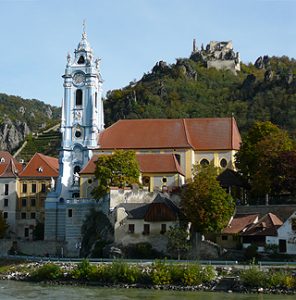
The tour of Dürnstein starts at the landing stage by the river and approaches the town from the South. At the south-eastern end, there is the option of going up to the castle (shown on the map below in yellow). Alternatively the story of the castle and Richard the Lionheart can be listened to from below. Thereafter the route shown in red winds through the town, covering a range of themes that include the abbey and the convent. After returning to the river, the high street is followed back to the eastern end of the town. Following the violet route will then uncover a further slate of stories. These begin with the story of how saffron came to the Wachau. There is then the story of how saffron-growing was revived through a discovery in a monastic library. Also with something for the palate are the abbey cellars and the wines that are made there. As with the castle, the gastronomic items of the violet tour can be listened without having to walk to the places concerned. The red tour, without the castle and gastronomic extras, will take at least an hour. For the whole of the yellow castle tour at least an hour and a half should be reckoned with. If the second castle is left out then the main castle can is easily done in an hour. Although the gastronomic items of the violet tour can be done in half an hour, if the premises are visited, this will require additional time. To open up the itinerary and start the tour click on the title above. Text: Alexander H. Curtis, all rights reserved.
